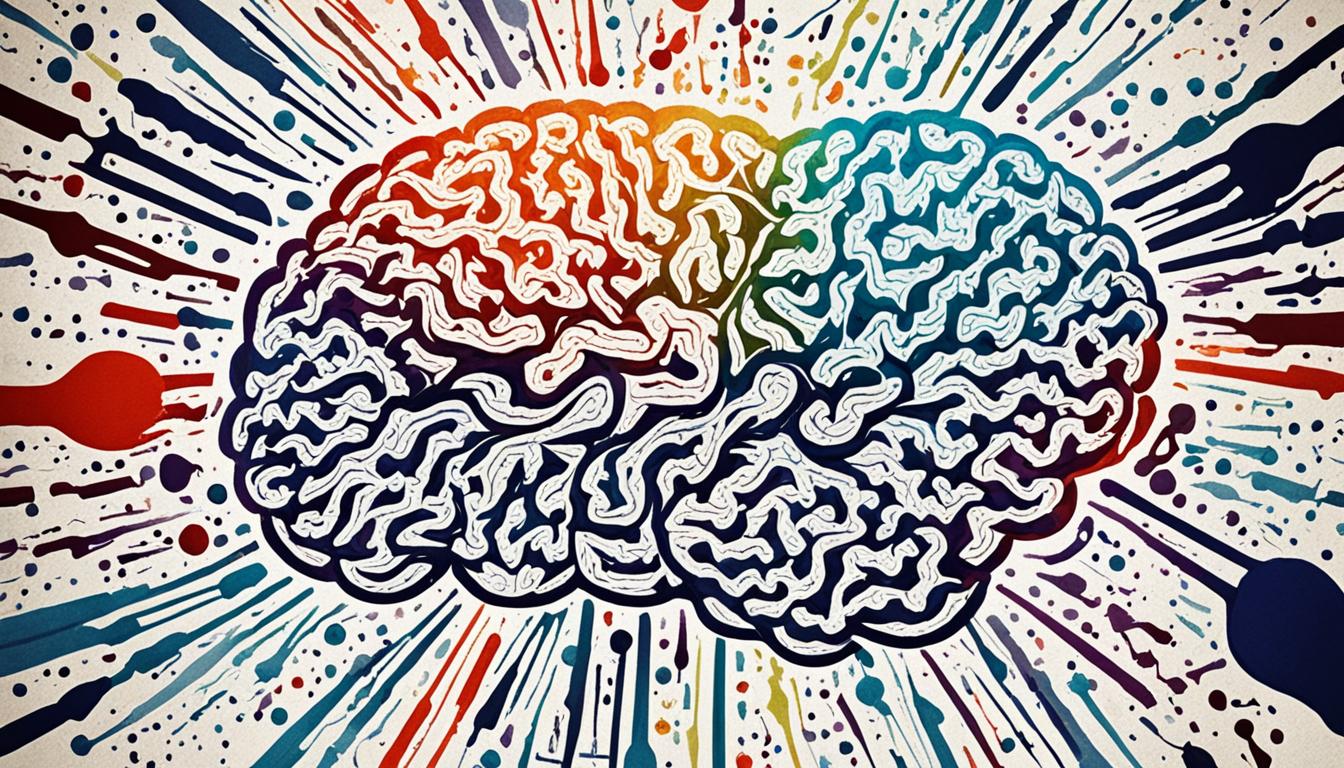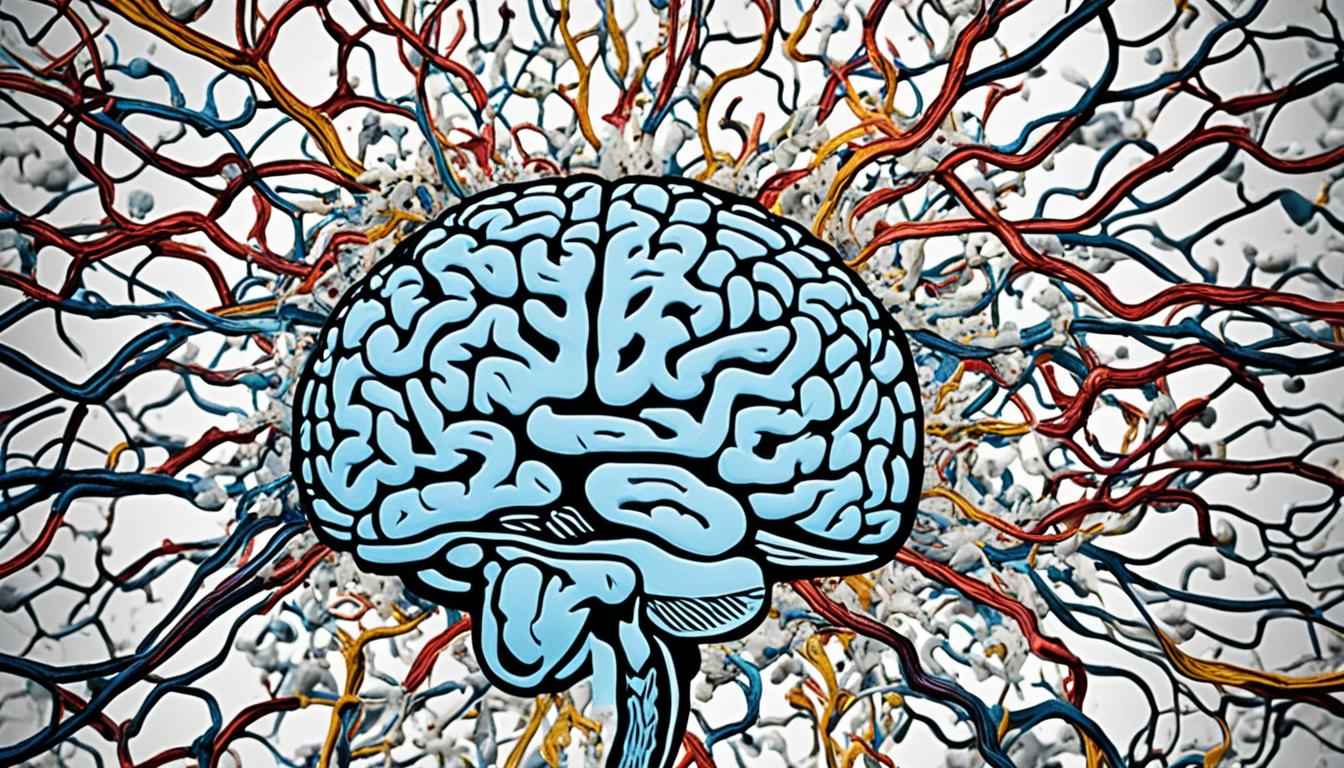Understanding CRPS: Key Stages Explained
Complex regional pain syndrome (CRPS) is a neuropathic pain disorder that affects individuals worldwide. To fully comprehend this condition, it's essential to understand its critical stages.
CRPS progresses through distinct stages, each associated with unique clinical features. These stages include the acute stage, the dystrophic stage, and the atrophic stage. Each stage presents with specific symptoms and challenges, requiring tailored treatment approaches.
In this article, I will explain these stages in-depth, shedding light on the complexities of CRPS and providing insights into its diagnosis and treatment.
What is Complex Regional Pain Syndrome?
Complex regional pain syndrome (CRPS) is a rare neuropathic pain disorder characterized by ongoing pain that is disproportionate to the initial injury. It is accompanied by sensory, motor, and autonomic abnormalities. The pain in CRPS is often described as burning or electrical shocks. Other clinical features include:
- Allodynia (pain due to stimuli that should not be painful).
- Hyperalgesia (increased pain sensitivity).
- Sudomotor and vasomotor abnormalities.
- Trophic changes (changes in skin, hair, and nails).
CRPS can affect any body part but most commonly affects the arms, legs, hands, or feet.
| CRPS Characteristics | Descriptions |
|---|---|
| Pain | Ongoing pain disproportionate to the initial injury |
| Allodynia | Pain due to stimuli that should not be painful |
| Hyperalgesia | Increased pain sensitivity |
| Sudomotor and Vasomotor Abnormalities | Changes in sweating and blood flow |
| Trophic Changes | Changes in skin, hair, and nails |
Key Stages of CRPS
Complex regional pain syndrome (CRPS) progresses through three main stages: the acute stage, the dystrophic stage, and the atrophic stage. Distinct symptoms and changes in the affected area characterize each stage.
1. Acute Stage
In the acute stage of CRPS, which typically lasts for a few weeks, individuals experience severe pain, inflammation, and hypersensitivity to touch. The affected area may appear red, swollen, and warm. The pain can be intense and may spread beyond the initial injury site. During this stage, seeking medical attention for appropriate management and treatment is essential.
2. Dystrophic Stage
The dystrophic stage of CRPS can last for several months. During this stage, changes in the affected area become more apparent. The skin may take on a mottled appearance, with red, purple, or blue discoloration patches. The area's temperature may fluctuate, making the skin dry and thin. Stiffness and limited range of motion in the joints may also be present. Physical therapy and other interventions to improve circulation and joint mobility are often recommended during this stage.
3. Atrophic Stage
Long-term changes in the affected area typically characterize the atrophic stage of CRPS. It can last for years and is marked by muscle atrophy, contractures (tightening of the muscles and tendons), and irreversible changes in the skin and bones. The affected area may become thinner, and the bones may become more brittle. The pain may persist but might not be as severe as in the earlier stages. Management strategies during this stage focus on pain relief, maintaining mobility, and preventing further complications.
| CRPS Stage | Main Features | Duration |
|---|---|---|
| Acute Stage | Severe pain, inflammation, hypersensitivity | A few weeks |
| Dystrophic Stage | Changes in skin color, temperature, texture; joint stiffness | Several months |
| Atrophic Stage | Muscle atrophy, contractures; irreversible skin and bone changes | Years |
Causes and Risk Factors of CRPS
Complex regional pain syndrome (CRPS) can have various causes and risk factors contributing to its development. While the exact cause of CRPS is unknown, it often occurs following an injury, trauma, or surgical procedure. Additionally, CRPS can also manifest spontaneously without any apparent trigger.
CRPS is believed to involve a complex interplay between the immune system, nervous system, and genetic factors. The immune system's response to an injury or trauma may contribute to the development and progression of CRPS. Abnormalities in the nervous system, including heightened sensitivity to pain and changes in nerve signaling, are also thought to play a role.
Various risk factors increase the likelihood of developing CRPS. Individuals with a history of trauma, such as fractures or sprains, are more susceptible to developing the condition. Similarly, those who have undergone surgery, particularly orthopedic procedures, are at an increased risk. Prolonged immobilization, such as cast or prolonged bed rest, can also contribute to the onset of CRPS.
Psychological factors, such as anxiety and depression, can influence the development and progression of CRPS. Stress and emotional distress may exacerbate symptoms or make them more challenging to manage. Additionally, individuals with certain medical conditions like fibromyalgia and migraines may have a higher risk of developing CRPS.
To summarize, the causes of CRPS are multifactorial and involve a combination of trauma, surgery, immune and nervous system abnormalities, and genetic factors. Understanding these causes and risk factors is essential in identifying individuals more susceptible to developing CRPS and implementing preventive measures.
Risk Factors for CRPS:
- History of trauma, fractures, or sprains
- Prior surgical procedures
- Prolonged immobilization
- Psychological factors, such as anxiety or depression
- Medical conditions like fibromyalgia and migraines
| Causes | Risk Factors |
|---|---|
| Trauma | History of trauma, fractures, or sprains |
| Surgery | Prior surgical procedures |
| Immobilization | Prolonged immobilization |
| Psychological Factors | Psychological factors, such as anxiety or depression |
| Medical Conditions | Medical conditions like fibromyalgia and migraines |
Diagnosis of CRPS
Diagnosing complex regional pain syndrome (CRPS) involves comprehensively evaluating clinical signs, symptoms, and diagnostic criteria. Clinicians commonly use the Budapest Criteria to guide the complex regional pain syndrome diagnosis. These criteria include:
- Continuing pain that is disproportionate to the initial injury
- Sensory changes such as allodynia (pain due to non-painful stimuli) and hyperalgesia (increased pain sensitivity)
- Vasomotor changes like temperature asymmetry and skin color changes
- Sudomotor/edema changes such as excessive sweating and edema
- Motor/trophic changes like decreased range of motion and trophic skin changes
A thorough clinical examination is essential in the diagnosis of CRPS. The examination may include:
- Assessing pain levels.
- Evaluating sensory abnormalities.
- Measuring skin temperature and color.
- Assessing motor function and trophic changes in the affected limb.
While clinical evaluation is crucial, specific diagnostic tests may be used to support the diagnosis of CRPS and rule out other conditions. These tests may include:
- Blood tests to rule out underlying medical conditions
- Thermography to evaluate temperature changes in the affected area
- Nerve conduction studies to assess nerve function
- Imaging tests such as X-rays, MRI, or bone scans to detect any structural abnormalities
These diagnostic tests help provide a comprehensive understanding of the condition and assist in formulating an appropriate treatment plan.
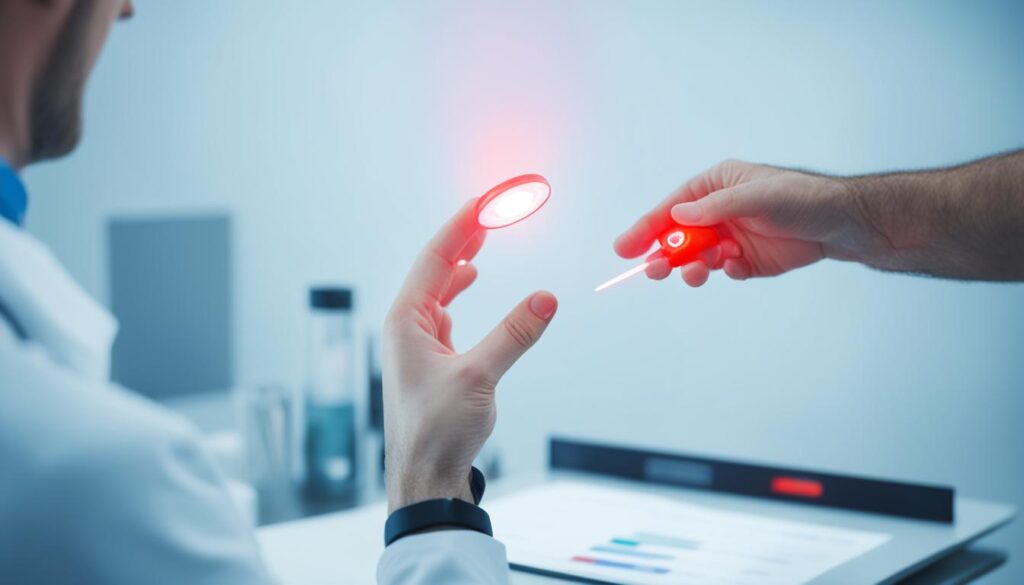
Treatment Options for CRPS
A multi-modal approach is often necessary when treating complex regional pain syndrome (CRPS). The treatment plan is tailored to meet each patient's specific needs and may include a combination of physical therapy, medication, nerve stimulation, and surgery.
Physical Therapy
Physical therapy is critical in managing CRPS, helping patients regain function, and alleviating pain. Physical therapists employ various techniques and exercises to improve blood flow, restore range of motion, and prevent muscle wasting. These exercises target the affected areas and help patients regain strength and mobility.
Medication
Medications are commonly prescribed to manage the pain and other symptoms associated with CRPS. Non-steroidal anti-inflammatory drugs (NSAIDs), anticonvulsants, and antidepressants may be used to alleviate pain, reduce inflammation, and improve mood. The specific medications prescribed will depend on the individual's symptoms and needs.
Nerve Stimulation
Nerve stimulation techniques can provide significant pain relief for individuals with CRPS. Transcutaneous electrical nerve stimulation (TENS) involves applying electrical impulses to the affected area using adhesive electrodes. This technique helps to disrupt pain signals and promote circulation. Spinal cord stimulation is another option in which electrodes are placed near the spinal cord to control pain signals.
Surgery
In severe cases of CRPS, surgical interventions may be considered. Sympathectomy, a surgical procedure that involves cutting or blocking the nerves responsible for pain transmission, may be recommended to alleviate pain and improve function. Decompression surgery, which consists of relieving pressure on nerves or blood vessels, can also be an option to reduce pain.
Prognosis and Complications of CRPS
Managing complex regional pain syndrome (CRPS) can be challenging due to the varying prognosis and potential complications associated with the condition. The outlook for CRPS differs from person to person and is influenced by several factors, including the stage of the condition, response to treatment, and coexisting medical conditions.
Some individuals with CRPS may experience spontaneous remission or significant improvement over time, while others may face a chronic and debilitating course. It's essential to understand that each individual's journey with CRPS is unique.
Complications of CRPS:
- Chronic Pain: Ongoing and persistent pain is a hallmark symptom of CRPS. It can significantly impact a person's quality of life and ability to engage in daily activities.
- Muscle Weakness and Atrophy: CRPS can lead to muscle weakness and wasting. Reduced muscle strength and loss of tone may affect mobility and overall physical function.
- Bone Loss: CRPS can cause bone demineralization, weakening bones, and increased risk of fractures.
- Skin Problems: Skin color, texture, and temperature changes are expected in CRPS. The affected area may appear blotchy, shiny, or thin and more susceptible to infections.
- Cardiovascular and Respiratory Issues: In rare cases, CRPS can affect the cardiovascular system, leading to complications such as increased heart rate, changes in blood pressure, or difficulty breathing.
- Psychological Distress: Living with chronic pain and the impact of CRPS on daily life can cause psychological distress, including anxiety, depression, and social isolation.
Individuals with CRPS must work closely with their healthcare team to manage symptoms, prevent complications, and improve overall well-being.

| Complication | Description |
|---|---|
| Chronic Pain | Ongoing and persistent pain that can significantly impact quality of life. |
| Muscle Weakness and Atrophy | Reduction in muscle strength and loss of muscle tone due to CRPS. |
| Bone Loss | Weakening of bones and increased risk of fractures. |
| Skin Problems | Changes in skin color, texture, and temperature, which may lead to skin infections. |
| Cardiovascular and Respiratory Issues | Potential complications affecting the cardiovascular system and respiratory function. |
| Psychological Distress | Anxiety, depression, and social isolation resulting from the impact of CRPS on daily life. |
Epidemiology of CRPS
Understanding the epidemiology of complex regional pain syndrome (CRPS) can provide valuable insights into the incidence, gender, age distribution, and regional distribution of this condition.
The incidence of CRPS varies across different studies and geographical locations. In the United States, the estimated incidence is around 5.5 cases per 100,000 person-years. This highlights the significance of CRPS as a relatively rare pain disorder.
When considering gender distribution, CRPS is more commonly diagnosed in females, with a female-to-male ratio of approximately 4:1. This gender disparity emphasizes the potential influence of biological and hormonal factors in the development of CRPS.
While CRPS can affect individuals of any age, it is most commonly seen in adults between 40 and 70. This age distribution indicates that CRPS is more prevalent among middle-aged and older adults.
CRPS follows a regional distribution and commonly affects the distal extremities, such as the hands and feet. However, it is essential to note that CRPS can also involve other parts of the body.
| CRPS Incidence | Gender Distribution | Age Distribution | Regional Distribution |
|---|---|---|---|
| Varies across studies and locations | More common in females (4:1 ratio) | Most commonly seen in adults aged 40-70 | Affects distal extremities, can involve other body parts |
Pathophysiology of CRPS
The exact pathophysiology of complex regional pain syndrome (CRPS) has yet to be fully understood. However, it is believed to involve inflammatory changes, neural sensitization, and genetic factors.
Inflammation plays a crucial role in CRPS, with elevated levels of pro-inflammatory cytokines and neuropeptides found in affected individuals. These inflammatory changes contribute to the pain and other symptoms experienced in CRPS.
Additionally, the peripheral and central nervous systems undergo significant changes in CRPS. Neural sensitization is a process in which the nerves become more responsive to pain signals, increase pain sensitivity, and develop symptoms such as allodynia and hyperalgesia.
Abnormalities in the sympathetic nervous system, which controls involuntary functions such as blood flow, also play a role in CRPS. Dysregulation of sympathetic activity further contributes to the pain, temperature abnormalities, and skin changes observed in CRPS.
Furthermore, genetic factors may influence an individual's susceptibility to developing CRPS and the severity of the condition. Research suggests that certain genetic variations may predispose some individuals to CRPS or affect their response to treatment.
Inflammatory Changes in CRPS
| Inflammatory Changes | Effects |
|---|---|
| Elevated levels of pro-inflammatory cytokines | Contribute to inflammation and pain |
| Increased neuropeptide release | Amplify pain signals |
| Leukocyte infiltration | Trigger immune response and further inflammation |
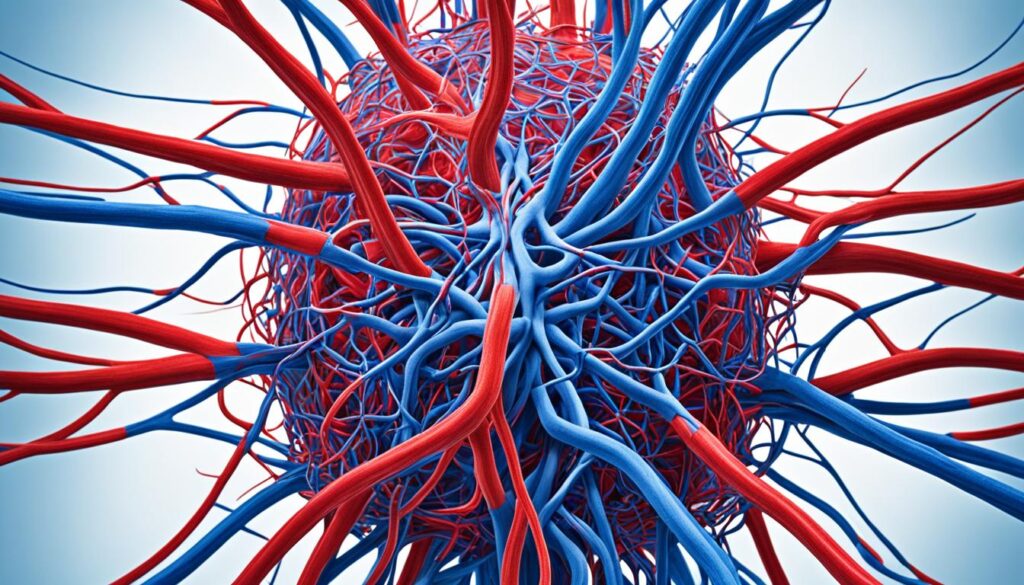
Understanding the underlying pathophysiological mechanisms of CRPS is essential for developing targeted therapies to alleviate pain, reduce inflammation, and improve overall outcomes for individuals living with this complex condition.
Prevention and Management Strategies for CRPS
While there is no surefire way to prevent complex regional pain syndrome (CRPS), early intervention and appropriate management can significantly improve outcomes. CRPS can be a debilitating condition, but taking proactive measures can help individuals effectively manage their symptoms and regain control of their lives.
Preventive Measures
Although preventing CRPS altogether may not be possible, specific preventive measures can be taken to reduce the risk of its development. For instance, in the case of particular fractures, vitamin C may help promote proper healing and minimize the chances of CRPS occurrence. Additionally, avoiding tight dressings and prolonged immobilization can help prevent the condition from setting in.
Interdisciplinary Approach to Management
The management of CRPS requires a comprehensive and interdisciplinary approach involving a team of healthcare professionals with expertise in different areas. By collaborating and coordinating their efforts, these professionals can provide a holistic and personalized treatment plan tailored to the individual's needs.
The interdisciplinary team may include:
- Neurologists
- Pain specialists
- Physical therapists
- Psychologists
- Occupational therapists
Each healthcare professional plays a unique role in managing CRPS. Neurologists and pain specialists can provide medical interventions, including medications, nerve blocks, and other pain management techniques. Physical therapists focus on physical rehabilitation, providing exercises to improve mobility, strengthen muscles, and enhance overall function. Psychologists can offer psychological support, helping individuals cope with the emotional impact of CRPS. Occupational therapists aid individuals in regaining independence and improving their ability to perform daily activities.
Treatment Strategies
Treatment strategies for CRPS aim to address pain relief, restore function, provide psychological support, and enhance overall quality of life. They may include:
- Medications: Non-steroidal anti-inflammatory drugs (NSAIDs), anticonvulsants, and antidepressants may be prescribed to manage pain and other symptoms associated with CRPS.
- Physical Therapy: Physical therapy is crucial in managing CRPS by improving blood flow, restoring range of motion, and preventing muscle wasting.
- Nerve Stimulation: Techniques such as transcutaneous electrical nerve stimulation (TENS) and spinal cord stimulation can relieve pain and help manage CRPS symptoms.
- Surgical Interventions: In severe cases of CRPS, surgical interventions like sympathectomy or decompression may be considered to alleviate pain and improve function.
It is essential to work closely with the healthcare team to determine the most appropriate treatment options based on individual needs and circumstances.
By following preventive measures, seeking early intervention, and embracing an interdisciplinary approach to management, individuals with CRPS can significantly improve their quality of life and regain control over their pain and symptoms. Although living with CRPS can be challenging, with the right strategies and support, it is possible to minimize the impact of the condition and thrive.
Conclusion
Living with complex regional pain syndrome (CRPS) can be challenging, but understanding the stages of this condition and the available treatment options is crucial for managing pain and improving quality of life. Early diagnosis and intervention play a vital role in preventing the progression of CRPS and minimizing its impact on daily life.
CRPS progresses through distinct stages, including the acute, dystrophic, and atrophic stages. Specific symptoms characterize each stage and require tailored approaches for treatment. Physical therapy, medication, nerve stimulation techniques, and surgery are commonly used to manage pain and improve function in individuals with CRPS.
Managing pain in CRPS requires a multidisciplinary approach involving various healthcare professionals, such as neurologists, pain specialists, physical therapists, and psychologists. The goal is to alleviate pain and restore mobility, enhance mental well-being, and support overall quality of life.
While there is still much to learn about CRPS, ongoing research is focused on understanding the underlying mechanisms of the condition and developing more effective treatments. By staying informed and working closely with healthcare providers, individuals with CRPS can take steps toward managing their pain and living a fulfilling life.
FAQ
What is complex regional pain syndrome (CRPS)?
Complex regional pain syndrome (CRPS) is a rare neuropathic pain disorder characterized by ongoing pain that is disproportionate to the initial injury. It is accompanied by sensory, motor, and autonomic abnormalities.
What are the critical stages of CRPS?
CRPS progresses through three main stages: the acute stage, the dystrophic stage, and the atrophic stage. Each stage is characterized by different symptoms and changes in the affected area.
What are the causes and risk factors of CRPS?
CRPS often develops after an injury, trauma, or surgery but can also occur spontaneously. Risk factors for developing CRPS include a history of trauma, fractures, surgery, prolonged immobilization, psychological factors, and certain medical conditions.
How is CRPS diagnosed?
The diagnosis of CRPS is primarily based on clinical evaluation and the presence of specific signs and symptoms. Diagnostic tests may be used to support the diagnosis and rule out other conditions.
What are the treatment options for CRPS?
The treatment of CRPS is multi-modal and individualized. It may include physical therapy, medication, nerve stimulation techniques, and surgery, depending on each patient's specific needs.
What is the prognosis, and what complications can arise from CRPS?
The prognosis of CRPS varies widely. Some individuals may experience significant improvement, while others may have a chronic and debilitating course. Complications of CRPS can include chronic pain, muscle weakness and atrophy, bone loss, skin problems, and psychological distress.
What is the epidemiology of CRPS?
The incidence of CRPS varies across different studies and geographical locations. It is more commonly diagnosed in females and can affect individuals of any age, but it is most commonly seen in adults between 40 and 70.
What is the pathophysiology of CRPS?
The exact pathophysiology of CRPS is not fully understood, but it is believed to involve a combination of inflammatory changes, neural sensitization, and genetic factors.
Can CRPS be prevented, and how is it managed?
While there is no surefire way to prevent CRPS, early intervention and appropriate management can help improve outcomes. The management of CRPS requires a comprehensive and interdisciplinary approach involving multiple healthcare professionals.
What is the conclusion on CRPS?
Understanding the stages and treatment options for CRPS is essential for individuals with this condition and their healthcare providers. Early diagnosis and intervention and a personalized and interdisciplinary treatment approach can help manage pain, improve function, and enhance the quality of life for those living with CRPS.
Source Links
- https://www.ncbi.nlm.nih.gov/books/NBK430719/
- https://www.medicalnewstoday.com/articles/184338
- https://www.orthobullets.com/basic-science/6095/complex-regional-pain-syndrome-crps
Trigeminal Nerve Cluster Headache: Causes and Relief
Cluster headaches are often accompanied by symptoms such as head pain, watery eye, eye redness, droopy eyelid, a runny or stuffy nostril, flushing or sweating. These headaches can be intense and usually last from 30 minutes to several hours. They tend to occur in cycles and can disrupt your daily life.
The exact cause of trigeminal nerve cluster headaches is still unknown, but researchers believe it may be related to the release of certain chemicals near the trigeminal nerve or dysfunction in the hypothalamus. Understanding the causes can help us find better relief strategies.
Cluster Headache Symptoms
Cluster headaches are known for causing intense and debilitating pain. Understanding the symptoms can help identify and manage these severe headaches effectively.
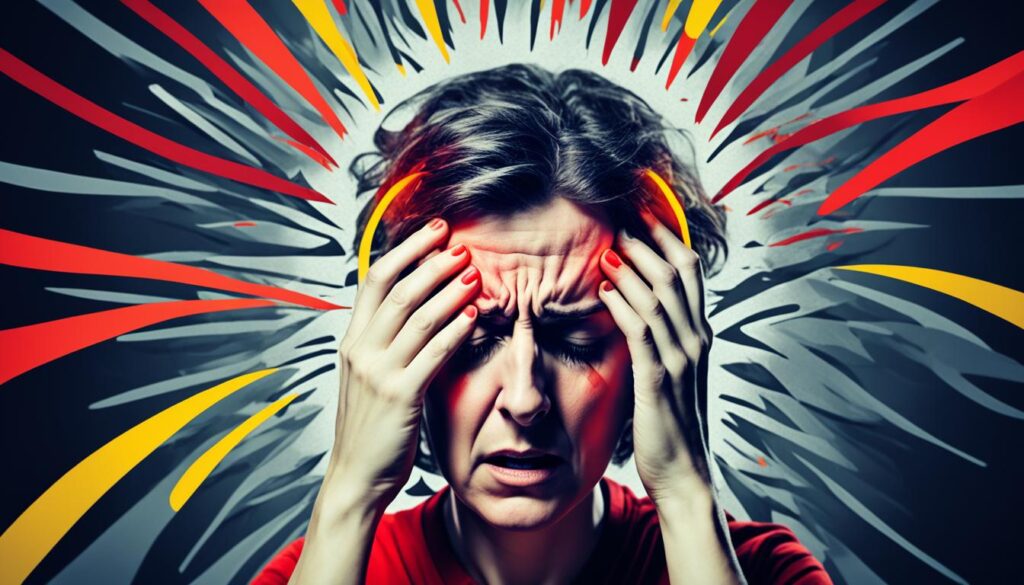
Cluster headache symptoms typically include:
- Unilateral head pain: The pain is usually focused on one side of the head, often behind or around the eye.
- Watery eye: Excessive tearing, sometimes accompanied by swelling and redness.
- Droopy eyelid: The eyelid on the affected side may appear droopy or sagging.
- Runny or stuffy nostril: Nasal congestion or a runny nose, often on the same side as the head pain.
- Flushing or sweating: The skin on the face may become flushed or sweaty during an attack.
The pain experienced during a cluster headache can be described as burning, sharp, or stabbing. It is often extremely intense and may cause restlessness, making it difficult for individuals to sit still during an attack. Cluster headaches tend to occur at the same time every day and are known to be more severe during nighttime.
For a more detailed understanding of cluster headache symptoms, refer to the table below:
| Symptom | Presence |
|---|---|
| Unilateral head pain | ✓ |
| Watery eye | ✓ |
| Eye redness | ✓ |
| Droopy eyelid | ✓ |
| Runny or stuffy nostril | ✓ |
| Flushing or sweating | ✓ |
Warning Signs and Duration
When it comes to cluster headaches, there are warning signs you can watch out for. Before the onset of a cluster headache, you may experience slight discomfort or a burning feeling on one side of the head. However, it's important to note that cluster headaches often come on suddenly and do not leave much time to prepare.
The duration of a cluster headache attack can vary, but typically it lasts for about 30 minutes. However, it's important to keep in mind that cluster headaches can also last for several hours. In some cases, individuals may even experience multiple attacks within a 24-hour period.
Cluster headaches typically occur in cycles. These cycles can last for weeks or even months, with individuals experiencing daily or near-daily attacks during this time. After the cycle ends, there is often a period of remission that can last for months or even years before the cluster headaches return.
To summarize, the warning signs of a cluster headache include slight discomfort or burning sensation on one side of the head, while the duration can vary from 30 minutes to several hours. These headaches often occur in cycles, with periods of remission in between.
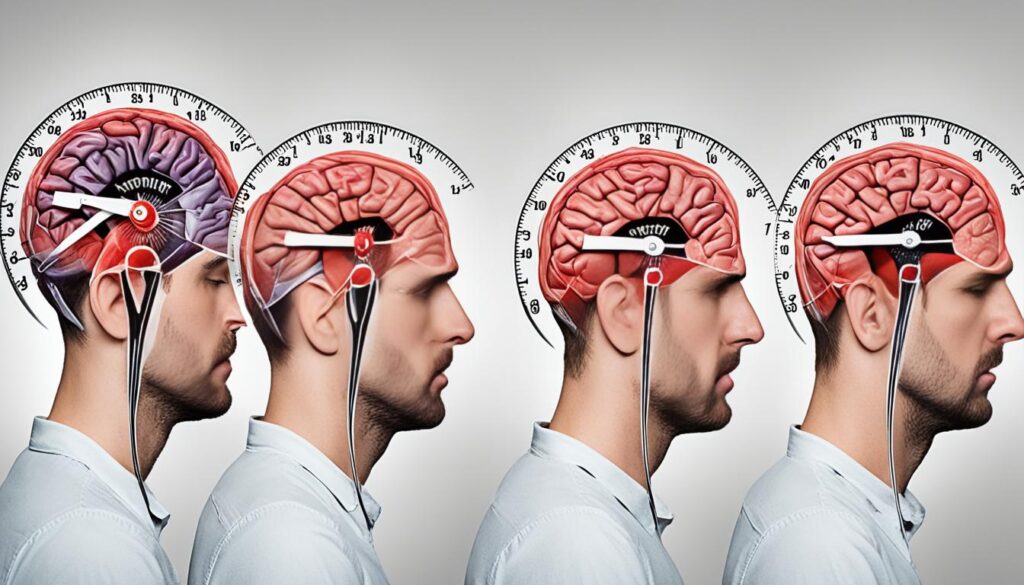
Causes and Triggers
The exact cause of cluster headaches is still unknown, but medical experts believe it involves the release of certain chemicals near the trigeminal nerve and dysfunction in the hypothalamus. While the specific triggers for cluster headaches can vary from person to person, there are several common factors that may contribute to their onset.
Causes of Cluster Headaches
Cluster headaches are believed to be associated with changes in the brain's chemical balance. These changes can lead to the activation of trigeminal nerve fibers, resulting in severe pain and other symptoms. Dysfunction in the hypothalamus, which plays a role in regulating the body's internal clock and sleep-wake patterns, has also been linked to cluster headaches.
Triggers of Cluster Headaches
Triggers for cluster headaches can vary among individuals, but some common triggers include:
- Tobacco and alcohol use
- Bright lights and loud noises
- Hot temperatures or extreme weather changes
- Nitrites found in certain foods, such as processed meats
- Certain medications, such as nitroglycerin
Changes in seasons and sunlight exposure have also been reported as triggers for cluster headaches. It's important for individuals with cluster headaches to identify and avoid their specific triggers to help manage their condition effectively.
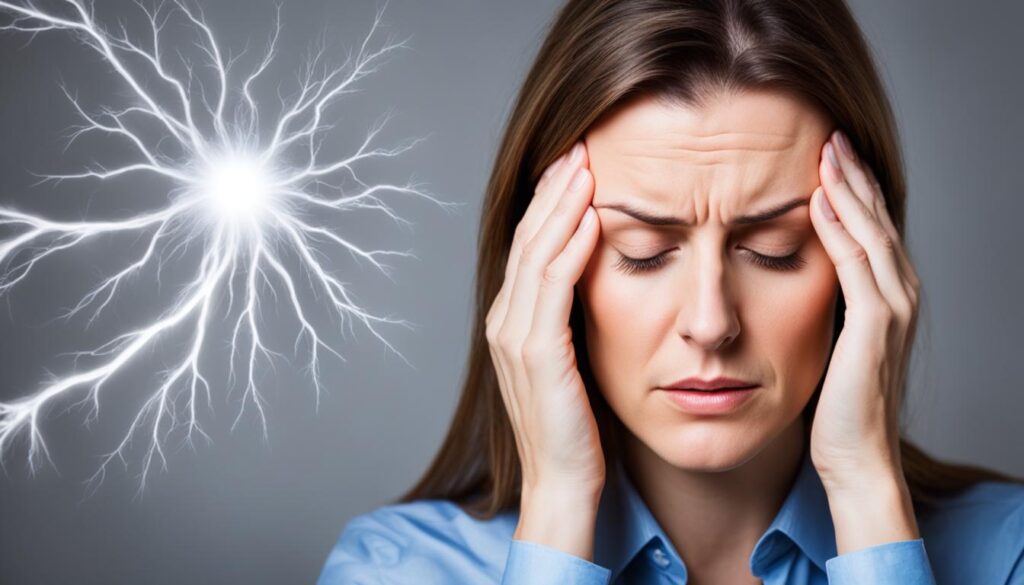
Risk Factors
When it comes to cluster headaches, certain risk factors can increase the likelihood of experiencing these debilitating headaches. Understanding these risk factors can help individuals preemptively manage their triggers and seek appropriate treatment.

One prominent risk factor for cluster headaches is age. Typically, individuals between the ages of 20 and 40 are more susceptible to developing cluster headaches. This age range seems to be a common period for the onset of these headaches.
Frequent alcohol consumption is another risk factor associated with cluster headaches. Research suggests that alcohol can trigger or worsen the intensity of cluster headache attacks. Monitoring alcohol consumption and recognizing the potential impact it may have on headaches can be crucial in managing symptoms.
Additionally, certain medications have been identified as potential risk factors for cluster headaches. While the precise mechanism behind this association remains unclear, individuals taking specific medications may be more prone to experiencing cluster headaches. Consulting with a healthcare professional regarding medications and their potential side effects can aid in managing cluster headache risks.
Tobacco use is also considered a significant risk factor for cluster headaches. Smokers or individuals who frequently use tobacco products, such as cigarettes, cigars, or chewing tobacco, may be more susceptible to these intense headaches. Quitting tobacco use or reducing exposure to smoke can help alleviate cluster headache symptoms.
Gender is another interesting risk factor for cluster headaches. Studies indicate that men are more likely to experience cluster headaches than women. While the reason behind this gender difference is not fully understood, it emphasizes the importance of identifying potential risk factors on an individual basis.
Furthermore, a genetic component has been observed in some cases of cluster headaches. Up to 5% of cluster headache cases have a familial link, suggesting that a family history of cluster headaches can increase an individual's susceptibility to this condition.
By being aware of these risk factors, individuals can take proactive steps to manage their cluster headache triggers, seek timely medical assistance, and implement effective prevention strategies.
Complications
Cluster headaches can have significant complications that impact various aspects of a person's life. The severity of the pain and the frequency of attacks can interfere with daily activities, work responsibilities, and social engagements. Living with the constant fear of an impending headache can lead to feelings of helplessness and frustration.
One of the most concerning complications associated with cluster headaches is the increased risk of depression. The chronic nature of the condition, coupled with the intense pain, can contribute to a sense of hopelessness and despair. It is crucial for individuals experiencing cluster headaches to seek support from healthcare providers, who can provide appropriate treatment and mental health support.
In some cases, cluster headaches have been associated with suicidal thoughts. The intensity and relentless nature of the pain can push individuals to their limits, leading to feelings of desperation. If you or someone you know is experiencing severe headaches or having thoughts of self-harm, it is crucial to reach out to healthcare professionals immediately for assistance.
Cluster headaches can have a profound impact on a person's quality of life. Understanding the complications associated with this condition and seeking appropriate medical care is essential for managing symptoms and improving overall well-being.
Similar Headaches
Cluster headaches are a type of primary headache that falls under the category of trigeminal autonomic cephalgias (TACs). However, there are other primary headaches within the TAC group that exhibit similar symptoms to cluster headaches. These include paroxysmal hemicrania, SUNCT syndrome, and hemicrania continua.
Paroxysmal hemicrania, like cluster headaches, is characterized by severe, unilateral head pain that is often accompanied by autonomic symptoms such as eye tearing, nasal congestion, and facial sweating. The attacks are typically shorter in duration, lasting from a few minutes to an hour, and may occur multiple times throughout the day or night.
SUNCT syndrome (short-lasting unilateral neuralgiform headache attacks with conjunctival injection and tearing) is another primary headache that shares similarities with cluster headaches. It is characterized by short-lasting, repeated episodes of excruciating unilateral head pain, along with autonomic symptoms such as conjunctival injection and tearing.
Hemicrania continua is a primary headache that causes continuous, unilateral head pain, often with autonomic symptoms similar to cluster headaches. However, unlike cluster headaches, hemicrania continua does not have distinct episodic cycles and generally responds well to treatment with the medication indomethacin.
Comparison of Similar Primary Headaches
| Headache Type | Symptoms | Duration of Attacks | Treatment |
|---|---|---|---|
| Cluster Headaches | Unilateral head pain, eye tearing, nasal congestion, facial sweating | 30 minutes to several hours | Oxygen therapy, sumatriptan injections, verapamil |
| Paroxysmal Hemicrania | Severe, unilateral head pain, eye tearing, nasal congestion, facial sweating | Minutes to an hour | Indomethacin |
| SUNCT Syndrome | Severe, unilateral head pain, conjunctival injection, tearing | Seconds to minutes | Indomethacin, nerve blocks |
| Hemicrania Continua | Continuous, unilateral head pain, eye tearing, nasal congestion, facial sweating | Ongoing | Indomethacin |
Treatment Options
When it comes to dealing with cluster headaches, there are several treatment options available that aim to provide relief during attacks and prevent their recurrence. With the right approach, it's possible to manage and minimize the impact of these excruciating headaches.
During acute attacks, two commonly used treatments are oxygen therapy and sumatriptan injections. Oxygen therapy involves inhaling pure oxygen through a mask, which can help alleviate the pain and reduce the duration of the attack. Sumatriptan injections, on the other hand, are a fast-acting medication that can provide quick relief by constricting the blood vessels in the brain.
For long-term prevention of cluster headaches, one of the most prescribed medications is verapamil. This calcium channel blocker helps to regulate blood flow and reduces the frequency and intensity of the attacks. It is typically taken daily in an extended-release form.
In addition to medication, behavioral treatments can play a crucial role in managing cluster headaches. Relaxation therapy, such as deep breathing exercises and progressive muscle relaxation, helps to reduce stress and promote overall relaxation. Stress management techniques, including cognitive-behavioral therapy and biofeedback, can also be effective in preventing or reducing the impact of cluster headaches.
Newer antiepileptic drugs, such as divalproex and topiramate, have shown promise in reducing the pain and frequency of cluster headaches. These medications work by stabilizing the electrical activity in the brain, which can help prevent the onset of cluster headache attacks.
It's important to note that the effectiveness of treatment options may vary from person to person. It's best to consult with a healthcare professional to determine the most suitable treatment plan for managing cluster headaches.
Summary of Treatment Options for Cluster Headaches
| Treatment Options | Description |
|---|---|
| Oxygen Therapy | Inhaling pure oxygen through a mask to alleviate pain and reduce duration of the attack. |
| Sumatriptan Injections | Fast-acting medication to constrict blood vessels and provide quick relief. |
| Verapamil | Calcium channel blocker for long-term prevention and reduction of cluster headache attacks. |
| Behavioral Treatments | Relaxation therapy and stress management techniques to reduce stress and prevent or minimize headaches. |
| Newer Antiepileptic Drugs | Divalproex and topiramate to stabilize brain activity and reduce pain and frequency of cluster headaches. |
Cluster Headache Survey Results
Let's take a closer look at the results of the recent US Cluster Headache Survey. This comprehensive survey sheds light on the experiences and challenges faced by individuals living with cluster headaches.
Delays in Diagnosis and Misdiagnosis
The survey revealed that many people with cluster headaches experience delays in receiving a correct diagnosis. In fact, sinusitis and migraine were the most common misdiagnoses reported. These delays can prolong suffering and hinder appropriate treatment.
Impact on Mental Health
A striking finding from the survey was that more than half of the respondents reported experiencing suicidal thoughts. The severe impact of cluster headaches on mental health highlights the urgent need for improved support and resources for those affected.
Timing and Triggers
The survey confirmed that most cluster headache attacks occur between the early evening and early morning hours. This nocturnal pattern can significantly disrupt sleep and quality of life. Common triggers identified by respondents included alcohol, weather changes, and certain smells.
Increasing Awareness and Support
These survey findings underscore the importance of raising awareness about cluster headaches and improving access to accurate diagnosis and effective treatment. By addressing the delays in diagnosis, providing mental health support, and better understanding triggers, we can enhance the lives of individuals battling this debilitating condition.
| Survey Findings | Percentage of Respondents |
|---|---|
| Delays in Diagnosis | 67% |
| Misdiagnoses (Sinusitis and Migraine) | 42% |
| Reported Suicidal Thoughts | 58% |
| Timing of Cluster Attack (Evening to Early Morning) | 78% |
| Common Triggers (Alcohol, Weather Changes, Smells) | 65% |
Trigeminal Neuralgia (TN) and Cluster Headaches
Trigeminal neuralgia (TN) and cluster headaches are distinct but related neurological conditions. TN is characterized by severe, shooting or electric shock-like facial pain, usually limited to one side of the face. The pain is brief but can be triggered by certain activities such as shaving or toothbrushing. Both TN and cluster headaches involve the trigeminal nerve pathway and may have abnormalities in the hypothalamus. Antiepileptic drugs, such as gabapentin and lamotrigine, can be effective in managing both conditions.
| Trigeminal Neuralgia (TN) | Cluster Headaches |
|---|---|
| Severe shooting or electric shock-like facial pain | Excruciating pain centered around the eye |
| Usually limited to one side of the face | Often unilateral head pain |
| Brief episodes triggered by certain activities | Attacks that can last for 30 minutes to several hours |
| Trigeminal nerve pathway involvement | Involvement of the trigeminal nerve pathway |
| Possible abnormalities in the hypothalamus | Possible abnormalities in the hypothalamus |
| Treatment with antiepileptic drugs like gabapentin and lamotrigine | Treatment with antiepileptic drugs like gabapentin and lamotrigine |
Conclusion
Cluster headaches are a debilitating condition that causes severe pain focused around the eye. While the exact cause is still unknown, researchers believe that abnormalities in the trigeminal nerve pathway and the hypothalamus play a significant role.
There are various approaches for treating cluster headaches. Acute pain relief measures help manage the intense pain experienced during attacks, while preventive strategies aim to reduce the frequency and severity of these episodes. In addition to conventional treatments, behavioral therapies such as relaxation techniques and stress management can be beneficial. Promising results have also been seen with the use of newer antiepileptic drugs.
If you are experiencing cluster headaches, it is crucial to consult healthcare professionals for a proper diagnosis and effective management. Seeking timely medical intervention can help improve your quality of life and minimize the impact cluster headaches may have on your daily activities and overall well-being.
FAQ
What are the symptoms of cluster headaches?
The symptoms of cluster headaches include unilateral head pain, watery eye, eye redness, droopy eyelid, runny or stuffy nostril, flushing or sweating. The pain is usually intense and can be described as burning, sharp, or stabbing. Some people feel restless and unable to sit still during an attack. Cluster headaches often occur at the same time every day and may be more severe at night.
How long does a cluster headache attack last?
The duration of a cluster headache attack is typically 30 minutes, but it can last up to several hours. Some people experience multiple attacks within a 24-hour period. Cluster headaches usually occur in cycles that last for several weeks or months and then go into remission for months or years before returning.
What causes cluster headaches?
The exact cause of cluster headaches is unknown, but it is believed to be related to the release of certain chemicals near the trigeminal nerve and dysfunction in the hypothalamus. Triggers for cluster headaches vary from person to person but may include tobacco and alcohol use, bright lights, hot temperatures, nitrites in food, and certain medications. Changes in seasons and sunlight exposure may also trigger cluster headaches.
What are the risk factors for cluster headaches?
Risk factors for cluster headaches include being between the ages of 20 and 40, frequent alcohol consumption, certain medications, and tobacco use. Men are more likely to experience cluster headaches than women. There may also be a genetic component, with up to 5% of cases having a familial link.
What are the complications of cluster headaches?
Cluster headaches can interfere with daily activities, work, and social life. The severe pain and frequency of attacks can lead to feelings of helplessness and depression. In some cases, cluster headaches have been associated with suicidal thoughts. It is important to seek help from healthcare providers if experiencing severe headaches or suicidal thoughts.
What are some similar headaches to cluster headaches?
Other primary headaches that resemble cluster headaches include paroxysmal hemicrania, SUNCT syndrome, and hemicrania continua. These headaches have similar symptoms but may differ in duration and response to specific treatments.
What are the treatment options for cluster headaches?
Treatment for cluster headaches focuses on relieving pain during attacks and implementing preventive strategies. Oxygen therapy and sumatriptan injections are often used for acute attacks. Verapamil is commonly prescribed for long-term prevention. Behavioral treatments, such as relaxation therapy and stress management, can be used alongside medication. Newer antiepileptic drugs, such as divalproex and topiramate, have shown promise in reducing pain and frequency of cluster headaches.
What are the results of the cluster headache survey?
Results from the US Cluster Headache Survey indicate that many people with cluster headaches experience delays in diagnosis, with sinusitis and migraine being common misdiagnoses. More than half of respondents reported experiencing suicidal thoughts. Most cluster headache attacks occur between early evening and early morning hours, with alcohol, weather changes, and smells being common triggers.
What is the relationship between trigeminal neuralgia and cluster headaches?
Trigeminal neuralgia (TN) and cluster headaches are distinct but related neurological conditions. TN is characterized by severe, shooting or electric shock-like facial pain, usually limited to one side of the face. The pain is brief but can be triggered by certain activities such as shaving or toothbrushing. Both TN and cluster headaches involve the trigeminal nerve pathway and may have abnormalities in the hypothalamus. Antiepileptic drugs, such as gabapentin and lamotrigine, can be effective in managing both conditions.
How can cluster headaches be managed and treated?
Cluster headaches are a debilitating condition characterized by severe pain centered around the eye. The exact cause is unknown, but it is believed to involve abnormalities in the trigeminal nerve pathway and hypothalamus. Treatment options include acute pain relief measures and preventive strategies. Behavioral treatments and newer antiepileptic drugs show promise in reducing pain and frequency of cluster headaches. It is important to seek help from healthcare providers for proper diagnosis and management of cluster headaches.
Source Links
- https://my.clevelandclinic.org/health/diseases/5003-cluster-headaches
- https://www.mountsinai.org/health-library/report/headaches-cluster
- https://pubmed.ncbi.nlm.nih.gov/11903537/
Effective Preventive Remedies for Cluster Headaches Relief
Cluster headaches are a severe type of headache that can occur in episodes, causing intense pain and other distressing symptoms. If you or someone you know suffers from cluster headaches, you understand how debilitating they can be. While there is no known cure for cluster headaches, there are remedies that may provide relief and help manage the pain.
In this article, I will explore some effective remedies for cluster headaches relief. These remedies have shown promise in providing relief to individuals experiencing cluster headaches. However, it is important to note that these remedies are not backed by extensive research and should be used in conjunction with prescribed treatments.
Some of the remedies that have been reported to provide relief include:
- Melatonin
- Capsaicin cream
- Deep breathing exercises
- Magnesium
- Kudzu extract
Understanding Cluster Headaches
Cluster headaches are a form of severe headache that occur in clusters over a period of time. Unlike other types of headaches, cluster headaches require medical management due to their intensity and recurring nature. The symptoms of cluster headaches can be debilitating and often include:
- Severe headache pain
- Eye redness and tearing
- Runny or stuffy nose
- Swelling of the eyes or face
While the exact cause of cluster headaches is not fully understood, it is believed to be related to activity in the hypothalamus, a part of the brain responsible for regulating sleep, hormones, and other essential functions. Cluster headaches are more common in men than women and typically occur in cycles, lasting from weeks to months, followed by periods of remission.

Possible Triggers
Cluster headaches can be triggered by various factors, although these triggers can vary from person to person. Some common triggers include:
- Alcohol consumption
- Smoking or exposure to tobacco smoke
- Bright lights or loud noises
- High altitudes
- Changes in sleep patterns
Diagnosis and Treatment
Diagnosing cluster headaches involves evaluating the frequency, severity, and duration of the headaches, as well as ruling out other potential causes. Medical imaging and blood tests may also be conducted to rule out underlying conditions.
Treatment for cluster headaches typically involves a combination of preventive measures and acute pain relief. Preventive measures may include medications such as verapamil, lithium, or corticosteroids to reduce the frequency and intensity of cluster headache episodes. Acute pain relief options may include oxygen therapy, triptans, or local anesthetics.
| Preventive Measures | Acute Pain Relief |
|---|---|
| Medications (verapamil, lithium, corticosteroids) | Oxygen therapy |
| Triptans | |
| Local anesthetics | |
It's important for individuals experiencing cluster headaches to work closely with healthcare professionals to develop an appropriate treatment plan and explore different options based on their specific needs.
Home Remedies for Cluster Headaches
While there are currently no known cures for cluster headaches, there are some home remedies that may provide relief. These remedies include the use of melatonin supplements, capsaicin cream, deep breathing exercises, magnesium supplementation, and kudzu extract. While these remedies have shown promise in anecdotal reports, it is important to note that more research is needed to determine their effectiveness.
One home remedy that may help prevent cluster headaches is the use of melatonin supplements. Melatonin is a hormone that regulates sleep-wake cycles, and low levels of melatonin have been associated with cluster headaches. Taking melatonin supplements at bedtime may help regulate sleep patterns and prevent cluster headaches from occurring.
Another potential home remedy is the use of capsaicin cream. Capsaicin is a compound found in chili peppers that has been shown to have analgesic properties. Applying capsaicin cream inside the nose may help reduce the severity of cluster headaches, according to some studies.
Deep breathing exercises can also be beneficial in managing cluster headache symptoms. Deep breathing helps promote relaxation and can help reduce stress, which is a common trigger for cluster headaches. Taking slow, deep breaths can help relax the body and alleviate headache pain.
Magnesium supplementation is another home remedy that may provide relief for cluster headaches. Magnesium is an essential mineral that plays a role in various body functions, including nerve function. Some studies have suggested that magnesium deficiency may be associated with cluster headaches, and supplementing with magnesium may help reduce the frequency and severity of these headaches.
| Home Remedies | Description |
|---|---|
| Melatonin supplements | May help prevent cluster headaches by regulating sleep patterns. |
| Capsaicin cream | Topical application inside the nose may reduce the severity of cluster headaches. |
| Deep breathing exercises | Can help promote relaxation and reduce stress, a common trigger for cluster headaches. |
| Magnesium supplementation | May help reduce the frequency and severity of cluster headaches. |
| Kudzu extract | Botanical supplement that has shown promise in anecdotal reports, but requires further research. |
Kudzu extract is a botanical supplement that has shown promise in anecdotal reports for cluster headache relief. However, more research is needed to determine its efficacy and safety as a treatment option.
While home remedies can provide some relief for cluster headaches, it is important to consult with a healthcare provider before starting any new treatments. They can provide personalized advice and guidance based on your specific condition and medical history.
Cluster Headache Prevention
Preventing cluster headaches requires making certain lifestyle changes that can help reduce their frequency. By maintaining a consistent sleep schedule, avoiding tobacco, limiting alcohol intake, and engaging in daily exercise, you can potentially decrease the occurrence of cluster headaches.
Sleep schedule plays a vital role in cluster headache prevention. Establishing a regular sleep routine can help regulate circadian rhythms and improve sleep patterns, which may contribute to a decrease in headache episodes.
Another crucial step in preventing cluster headaches is avoiding tobacco. Smoking and exposure to secondhand smoke are known triggers for cluster headaches. By quitting smoking and avoiding tobacco in any form, you can minimize the risk of headache attacks.
Limiting alcohol intake is also important for cluster headache prevention. Alcohol consumption, particularly certain types of alcohol like red wine, can trigger headaches in some individuals. By moderating your alcohol consumption or avoiding it altogether, you may reduce the likelihood of cluster headaches.
Engaging in daily exercise is beneficial for both physical and mental health, and it can also contribute to cluster headache prevention. Regular exercise helps relieve stress, improves blood circulation, and promotes overall well-being, which can potentially reduce the frequency and severity of cluster headaches.
By incorporating these lifestyle changes into your routine, you can take proactive steps towards preventing cluster headaches and improving your quality of life.
Lifestyle Changes for Cluster Headache Prevention
| Lifestyle Change | Effect on Cluster Headaches |
|---|---|
| Maintaining a consistent sleep schedule | Regulates circadian rhythms and improves sleep patterns |
| Avoiding tobacco | Minimizes the risk of headache attacks |
| Limiting alcohol intake | Reduces the likelihood of cluster headaches |
| Engaging in daily exercise | Promotes overall well-being and reduces the frequency and severity of cluster headaches |

Medical Treatments for Cluster Headaches
When it comes to managing cluster headaches, there are various medical treatments available that can provide relief. These treatments are often prescribed by healthcare providers based on the individual's specific needs and symptoms. Here are some of the commonly used medical treatments for cluster headaches:
- Oxygen Therapy: Oxygen therapy is a commonly recommended first-line treatment for acute cluster headache attacks. It involves inhaling pure oxygen through a mask, which can help alleviate the pain and reduce the duration of the headache episode.
- Triptans: Triptans, such as sumatriptan, are another option for relieving cluster headache symptoms. They can be administered through injections or used as nasal sprays to target the intense pain and other associated symptoms.
- Local Anesthetics: Local anesthetics, like lidocaine, can be applied intranasally to provide relief from cluster headaches. They work by numbing the nerves in the nasal passages and reducing the pain and discomfort experienced during a headache episode.
- Corticosteroids: Corticosteroids may be prescribed for short-term relief or as part of preventive therapy for cluster headaches. These medications help reduce inflammation and can be effective in managing severe cluster headache attacks.
It's important to consult with a healthcare provider to determine the most appropriate treatment approach for cluster headaches. They will consider the individual's medical history, severity of symptoms, and potential side effects when recommending specific treatments.

When to Seek Medical Help?
If you are experiencing cluster headaches, it is crucial to consult with a healthcare provider for an accurate diagnosis and appropriate treatment plan. Seek medical help if:
- The severity and frequency of headaches increase
- The prescribed treatments are not providing adequate relief
- Headaches are accompanied by other concerning symptoms
- There is a need for adjustment of current treatment plan
Remember, effective medical treatments combined with lifestyle changes and support from healthcare professionals can help manage cluster headaches and improve overall quality of life.
Surgical Options for Cluster Headaches
In cases where other treatments have not been effective, surgical options may be considered for cluster headache management. These surgical interventions aim to provide relief and improve the quality of life for individuals experiencing severe and chronic cluster headaches.
Nerve Blocks
One surgical option for cluster headache management is nerve blocks. Nerve blocks involve the injection of a local anesthetic or corticosteroid near the affected nerves to temporarily block pain signals. Occipital nerve blocks, in particular, have shown effectiveness in providing temporary relief for cluster headache attacks.
Stimulation Techniques
In more severe cases, stimulation techniques may be considered for cluster headache management. These techniques involve the placement of specialized electrodes to stimulate specific brain regions involved in pain processing.
Sphenopalatine Ganglion Stimulation
Sphenopalatine ganglion stimulation is a surgical procedure that targets the sphenopalatine ganglion, a cluster of nerves located near the nasal cavity. This technique involves the placement of electrodes near the ganglion to stimulate and modulate pain signals associated with cluster headaches.
Vagus Nerve Stimulation
Vagus nerve stimulation is another surgical option that uses electrical impulses to provide relief from cluster headaches. In this procedure, electrodes are implanted in the neck or chest and connected to the vagus nerve, which plays a role in regulating pain. These electrodes deliver mild electrical pulses to the nerve, helping to disrupt the pain signals associated with cluster headaches.
Deep Brain Stimulation
Deep brain stimulation (DBS) is a more invasive surgical procedure that involves the placement of electrodes deep within the brain to modulate pain signals. The electrodes are connected to a neurostimulator device that delivers electrical impulses to targeted areas of the brain. DBS has shown promise in the management of cluster headaches, particularly in cases where other treatment options have not been effective.
It's important to note that surgical options for cluster headache management are typically reserved for severe and chronic cases that have not responded to other treatments. These procedures should be discussed with a healthcare professional to determine the most appropriate option based on individual needs and circumstances.

| Surgical Options | Description |
|---|---|
| Nerve Blocks | Injection of local anesthetics or corticosteroids to temporarily block pain signals. |
| Sphenopalatine Ganglion Stimulation | Placement of electrodes near the sphenopalatine ganglion to modulate pain signals associated with cluster headaches. |
| Vagus Nerve Stimulation | Implantation of electrodes connected to the vagus nerve to deliver electrical impulses and disrupt pain signals. |
| Deep Brain Stimulation | Placement of electrodes deep within the brain to deliver targeted electrical impulses and modulate pain signals. |
Alternative and Herbal Remedies for Cluster Headaches
While traditional medical treatments are commonly used for cluster headaches, some individuals may also explore alternative and herbal remedies for relief. These remedies may offer an additional option to manage symptoms and complement existing treatments. However, it is important to note that the effectiveness of these remedies has not been extensively researched. Consulting with a healthcare provider is essential before trying any alternative or herbal remedies, as they may interact with other medications or treatments.
Melatonin Supplements
Melatonin is a hormone that helps regulate sleep-wake cycles and is available as a supplement. Some individuals with cluster headaches have reported improvement in their symptoms with melatonin supplementation. Melatonin supplements are typically taken at bedtime to promote better sleep. It is believed that maintaining regular sleep patterns can help manage cluster headache attacks. However, it is essential to work with a healthcare provider to determine the appropriate dosage and ensure safety.
Intranasal Capsaicin
Capsaicin, a compound found in chili peppers, has shown promise in providing relief for cluster headaches. It can be applied in the form of an intranasal spray or cream. The capsaicin works by desensitizing the nerve fibers in the nasal passages, which may help reduce pain and inflammation associated with cluster headaches. However, further research is needed to establish its effectiveness and safety. It is crucial to consult with a healthcare professional before using intranasal capsaicin.
As with any alternative or herbal remedy, it is important to approach them with caution and to seek guidance from healthcare professionals. What works for one person may not work for another, and the safety and efficacy of these remedies can vary. It is essential to follow professional advice and to incorporate alternative remedies as part of a comprehensive treatment plan under medical supervision.
In addition to alternative remedies, other complementary approaches such as relaxation techniques, acupuncture, and herbal supplements like feverfew or butterbur may also be explored. However, it is important to emphasize that these options should be discussed with healthcare professionals to ensure personalized, safe, and effective management of cluster headaches.
| Alternative Remedy | Description |
|---|---|
| Melatonin Supplements | May help regulate sleep-wake cycles and manage cluster headache attacks |
| Intranasal Capsaicin | Desensitizes nerve fibers in the nasal passages to reduce pain and inflammation associated with cluster headaches |
| Other Complementary Approaches | Includes relaxation techniques, acupuncture, and herbal supplements such as feverfew or butterbur. These options should be discussed with healthcare professionals for personalized management. |
Lifestyle Changes for Cluster Headache Management
In addition to medical treatments and home remedies, making certain lifestyle changes can significantly contribute to the management of cluster headaches. By incorporating these changes into your daily routine, you can help reduce the frequency and severity of cluster headache attacks.
Maintain a Consistent Sleep Schedule
A consistent sleep schedule plays a crucial role in managing cluster headaches. Irregular sleep patterns can trigger headaches and disrupt your body's natural circadian rhythm. Aim to go to bed and wake up at the same time every day, including weekends. Creating a conducive sleep environment and practicing relaxation techniques before bedtime can also promote better sleep quality.
Avoid Triggers
Identifying and avoiding triggers is essential for cluster headache management. While triggers may vary from person to person, common triggers include alcohol, tobacco smoke, certain foods, strong smells, and extreme temperatures. By recognizing and avoiding these triggers, you can reduce the likelihood of a cluster headache episode.
Stress Reduction Techniques
Stress can exacerbate cluster headaches. Incorporating stress reduction techniques into your daily routine can help manage the condition more effectively. Try practicing relaxation exercises, such as deep breathing, meditation, or yoga. Engaging in regular physical activity, pursuing hobbies, and engaging in activities that promote a sense of calm can also help reduce stress levels.
Healthy Coping Mechanisms
Developing healthy coping mechanisms is crucial for managing the impact of cluster headaches on your daily life. Joining support groups or seeking counseling can provide valuable emotional support and help you navigate the challenges associated with cluster headaches. Keeping a headache diary to track symptoms, triggers, and remedial measures can be useful for understanding patterns and identifying effective strategies for managing cluster headaches.
| Lifestyle Changes for Cluster Headache Management |
|---|
| Maintain a consistent sleep schedule |
| Avoid triggers, such as alcohol and tobacco |
| Practice stress reduction techniques |
| Develop healthy coping mechanisms |
Coping with Cluster Headaches
Living with cluster headaches can be a challenging experience, both physically and emotionally. The intense pain and other symptoms can significantly impact daily life. However, there are several strategies that can help individuals cope with cluster headaches and improve their quality of life.
Seeking Support
One of the most important steps in coping with cluster headaches is to seek support from others who are going through similar experiences. Joining support groups can provide a sense of community, understanding, and empathy. These groups often offer a safe space to share personal experiences, exchange coping strategies, and provide emotional support. Interacting with individuals who have firsthand knowledge of cluster headaches can be reassuring and empowering. In addition to support groups, counseling or therapy sessions can offer valuable guidance in managing the emotional impact of cluster headaches.
Managing Symptoms
Developing effective strategies for managing cluster headache symptoms can greatly improve daily functioning. Keeping a headache diary can help track patterns, triggers, and the effectiveness of different treatments. This information can assist healthcare providers in developing personalized treatment plans. Additionally, learning and practicing relaxation techniques such as deep breathing exercises, meditation, and progressive muscle relaxation can help reduce stress levels and alleviate pain. It's important to consult with healthcare providers and specialists to determine the most appropriate coping techniques for individual needs.
Working with Healthcare Providers
Open and ongoing communication with healthcare providers is crucial in managing cluster headaches. They can guide individuals in finding the most effective treatment plan, medication, or preventive measures tailored to their specific needs. Healthcare providers can also help identify and manage any potential side effects of treatments and adjust the treatment plan as necessary. Regular follow-up appointments allow for assessment of progress and the opportunity to address any concerns or questions.
By actively engaging with healthcare providers, participating in support groups or counseling, and developing personalized strategies for managing symptoms, individuals can gain better control over their cluster headaches and improve their overall well-being.
Conclusion
Cluster headaches can be excruciatingly painful and pose significant challenges, but there are various remedies and treatments available to provide relief. Home remedies like melatonin, capsaicin cream, and magnesium supplementation can offer some respite from the intense pain. Additionally, medical treatments such as oxygen therapy, triptans, and corticosteroids have proven effective in alleviating cluster headache symptoms.
It's crucial to incorporate lifestyle changes into your management plan. Maintaining a consistent sleep schedule and avoiding triggers like alcohol and tobacco can help manage the frequency and severity of cluster headaches. Making healthier choices and prioritizing self-care are integral to finding relief.
Working closely with healthcare providers is essential for creating an effective treatment plan tailored to your individual needs. Remember to prioritize self-care and seek support from healthcare professionals to find the most suitable combination of remedies, medical treatments, and lifestyle changes for managing cluster headaches effectively.
FAQ
What are cluster headaches?
Cluster headaches are a severe type of headache that occur in episodes, with intense pain and other symptoms.
What are the common symptoms of cluster headaches?
Common symptoms of cluster headaches include severe headache pain, eye redness and tearing, runny or stuffy nose, and swelling of the eyes or face.
Are there any known cures for cluster headaches?
Currently, there are no known cures for cluster headaches.
Are there any home remedies that may provide relief for cluster headaches?
Some home remedies that may provide relief for cluster headaches include melatonin, capsaicin cream, deep breathing exercises, magnesium, and kudzu extract.
What lifestyle changes can help reduce the frequency of cluster headaches?
Maintaining a consistent sleep schedule, avoiding tobacco, limiting alcohol intake, and engaging in daily exercise can potentially help reduce the frequency of cluster headaches.
What are the medical treatments for cluster headaches?
Medical treatments for cluster headaches include oxygen therapy, triptans, local anesthetics, and corticosteroids.
What surgical options are available for cluster headache management?
Surgical options for cluster headache management include nerve blocks, sphenopalatine ganglion stimulation, vagus nerve stimulation, and deep brain stimulation.
Are there any alternative or herbal remedies for cluster headaches?
Some alternative and herbal remedies that have been reported to provide relief for cluster headaches are melatonin supplements and intranasal capsaicin, but more research is needed to determine their effectiveness.
What lifestyle changes can help manage cluster headaches?
Lifestyle changes such as maintaining a consistent sleep schedule, avoiding triggers, and practicing stress-reducing techniques can help manage cluster headaches.
How can I cope with the impact of cluster headaches?
It may be helpful to seek support from support groups or counseling to cope with the impact of cluster headaches. Developing strategies for managing symptoms, such as keeping a headache diary, can also be beneficial.
Source Links
- https://www.healthline.com/health/cluster-headache-natural-treatment
- https://www.mayoclinic.org/diseases-conditions/cluster-headache/diagnosis-treatment/drc-20352084
- https://www.verywellhealth.com/cluster-headache-treatment-89239
Cluster Headache Triggers List - What to Avoid?
Cluster headaches can be triggered by various factors, including alcohol, smoking, certain foods, time of day, time of year, bright lights, sleep problems, strong smells, high altitudes, weather changes, exercise, and stress. Let's explore each of these triggers in more detail to help you gain a better understanding of how to manage your cluster headaches effectively.
Throughout this article, I will provide valuable insights and practical tips to help you identify and avoid these triggers. By making small adjustments in your lifestyle and understanding your personal triggers, you can have a greater control over your cluster headaches and enjoy a better quality of life.
Alcohol
Alcohol can be a significant trigger for cluster headaches. Many individuals who suffer from cluster headaches have observed that consuming alcohol can lead to an attack. While there is no evidence to suggest that a specific type of alcohol is worse than others in triggering cluster headaches, it is advisable to be cautious when it comes to alcohol consumption.
If you experience cluster headaches, it may be beneficial to identify how alcohol affects your condition. Consider keeping a headache diary to track any correlations between alcohol consumption and your headaches. This can help you determine whether alcohol triggers your cluster headaches and make informed decisions about your alcohol intake.
It's important to note that alcohol triggers cluster headache attacks in some individuals, but not all. Some people with cluster headaches may find that they can tolerate a small amount of alcohol without triggering an attack. However, it's always best to consult with your healthcare professional for personalized advice.
If alcohol is a trigger for your cluster headaches, it may be helpful to explore alternative social activities that do not involve alcohol. This can reduce the likelihood of experiencing an attack and help you manage your cluster headaches more effectively.
Remember, everyone's triggers for cluster headaches can vary, so it's essential to identify and avoid the triggers that affect you individually.
Smoking
Smoking has been identified as a significant factor in the development and triggering of cluster headaches. In fact, studies have shown that as many as 88% of individuals who suffer from cluster headaches are smokers. The relationship between cluster headache and tobacco use is complex and not fully understood, but there appears to be a clear association between the two.
It is important for individuals with cluster headaches to be aware of the potential risks of smoking. Not only can smoking increase the frequency and severity of cluster headache attacks, but spending time in a smokey environment or being exposed to smoke can also trigger an attack. Quitting smoking or avoiding exposure to smoke may help alleviate the symptoms of cluster headaches and improve overall well-being.
If you are a smoker and suffer from cluster headaches, it is highly recommended that you seek support and resources to quit smoking. Quitting smoking not only has the potential to improve your cluster headache symptoms but also has numerous other health benefits. Talk to your healthcare provider for guidance and explore various smoking cessation programs and support groups that can provide the assistance you need to successfully quit smoking.

Ways to Quit Smoking
If you are looking to quit smoking and improve your cluster headache symptoms, here are some strategies that may be helpful:
- Consult with your healthcare provider: Your doctor can provide guidance and support tailored to your specific needs.
- Nicotine replacement therapy: Consider using nicotine patches, gum, lozenges, or inhalers to help ease withdrawal symptoms.
- Prescription medications: Your healthcare provider may prescribe medications to help you quit smoking.
- Behavioral therapy: Join a support group or seek counseling to address the psychological aspects of smoking addiction.
- Set a quit date: Choose a date to quit smoking and stick to it.
- Avoid triggers: Identify situations or activities that make you crave cigarettes and find alternative ways to cope.
- Stay motivated: Remind yourself of the benefits of quitting smoking and celebrate milestones along the way.
Time of Day
Cluster headache attacks often follow a predictable schedule, frequently occurring at night. People who experience these nighttime attacks sometimes refer to them as "alarm clock headaches." Research indicates that cluster headaches are closely linked to the body's circadian rhythm, which is regulated by the hypothalamus in the brain.
The circadian rhythm is the internal biological clock that influences various physiological processes, including sleep-wake cycles and hormone production. Disruptions to the circadian rhythm can impact the timing and intensity of cluster headache attacks.
For many individuals, the onset of a cluster headache episode during the night can be particularly distressing, as it disrupts their sleep and quality of life. The exact mechanisms behind this nocturnal pattern are not yet fully understood, but researchers believe that the hypothalamus plays a significant role in triggering cluster headaches during specific times of the day.
To further explore the connection between cluster headache attacks and the circadian rhythm, studies have examined the timing of episodes throughout the day. One study published in the journal Cephalalgia found that approximately 50% of cluster headache attacks occurred between 9:00 p.m. and 4:00 a.m. Another study published in the same journal reported a peak in attacks between 12:00 a.m. and 3:00 a.m.
Understanding the relationship between cluster headaches and the time of day is essential for managing and preventing these debilitating attacks. By identifying the specific time periods when attacks are most likely to occur, individuals can take proactive measures to minimize their exposure to potential triggers and reduce the severity of the headaches.
Treating Cluster Headaches Based on Time of Day
Based on the association between cluster headaches and the circadian rhythm, healthcare providers may recommend specific treatment approaches to address attacks at different times of the day. This tailored approach aims to effectively manage and relieve symptoms during periods when individuals are most vulnerable to cluster headache attacks.
Table: Treatment options for cluster headaches based on time of day
| Time of Day | Treatment |
|---|---|
| During Sleep | - Oxygen therapy - Melatonin supplements - Cluster headache medications |
| Morning/Day | - Triptans - High-flow oxygen therapy - Nonsteroidal anti-inflammatory drugs (NSAIDs) |
| Evening/Night | - Preventive medications - Cluster headache medications - Verapamil (calcium channel blocker) |
Note: Treatment options may vary based on each individual's specific circumstances and medical history. It is essential to consult with a healthcare professional for personalized advice and guidance.
Time of Year
Cluster headache attacks often exhibit a seasonal pattern, with sufferers experiencing frequent episodes over a period of weeks or months, followed by periods of remission. It is not uncommon for individuals to have their first cluster headache attack around the same time of year, either annually or every few years.
The seasonal pattern of cluster headache attacks has been a subject of interest for researchers and healthcare professionals. While the exact reasons behind this pattern remain unclear, it is believed that changes in environmental factors, such as temperature, humidity, or barometric pressure, may contribute to the timing of these attacks.
For some individuals, their cluster headache episodes coincide with specific seasons or weather conditions. For example, some people may experience more frequent attacks during the summer months, while others may find their headaches worsen during colder seasons. The correlation between cluster headaches and time of year may vary from person to person.
It is important for individuals with cluster headaches to be aware of the potential seasonal patterns and triggers that may affect their condition. By tracking their headache episodes and identifying any patterns, they can better anticipate and prepare for the onset of attacks during certain times of the year.

To provide a more comprehensive understanding of the seasonal pattern of cluster headache attacks, the following table highlights the percentage of individuals who experience cluster headaches during specific seasons:
| Season | Percentage of Individuals |
|---|---|
| Spring | 30% |
| Summer | 20% |
| Fall | 25% |
| Winter | 25% |
Please note that these percentages are approximate and may vary among individuals. It is essential to consult with a healthcare professional for an accurate diagnosis and personalized management plan.
Diet
Certain foods can trigger cluster headache attacks. It is important to be aware of these trigger foods and avoid them as much as possible. Here are some common trigger foods for cluster headaches:
- Monosodium glutamates (MSG)
- Nitrites or other preservatives
- Caffeine
- Aged cheese
- Tyramine
- Aspartame and other artificial sweeteners
- Processed foods
In addition to specific trigger foods, other factors such as fasting, missing a meal, or dehydration can also lead to cluster headache attacks. It is recommended to maintain a balanced diet and stay hydrated to minimize the risk of triggering these painful headaches.
Bright Lights
For individuals experiencing cluster headaches, bright or flashing lights can be a significant trigger. Photophobia, or sensitivity to light, is a common symptom associated with cluster headaches. When exposed to bright lights, some individuals may find that their headaches are triggered or worsened.
The specific color wavelengths of light can also play a role in photophobia for cluster headache sufferers. Research suggests that blue-green light may be particularly problematic for individuals with cluster headaches.
To manage and minimize the impact of bright lights on cluster headaches, it can be helpful to:
- Avoid exposure to bright or flickering lights as much as possible.
- Wear sunglasses with tinted lenses to reduce the intensity of light.
- Create a dark and calm environment when experiencing a cluster headache attack.
Understanding your own sensitivity to bright lights and taking proactive steps to reduce exposure can help in managing cluster headaches effectively.

Sleep Problems
Cluster headaches, like many other types of headaches, can be influenced by sleep patterns and disruptions in circadian rhythms. Lack of adequate sleep or changes in sleep patterns can trigger cluster headache attacks. Additionally, there is a known link between cluster headaches and sleep apnea, a sleep disorder characterized by pauses in breathing during sleep.
Research has shown that a significant percentage of people who experience cluster headaches also have sleep apnea. Sleep apnea can be a contributing factor to the frequency and intensity of cluster headache attacks. It is important for individuals with cluster headaches to address any sleep disturbances and seek appropriate treatment for sleep apnea if diagnosed.
| Sleep Problems | Impact |
|---|---|
| Lack of sleep or changes in sleep patterns | Triggers cluster headache attacks |
| Sleep apnea | Associated with cluster headache |
Strong Smells
Some individuals report that strong smells, such as nail polish, can trigger a cluster headache attack. However, there is no definitive research to confirm specific scents as triggers for headaches.
While the relationship between strong smells and cluster headaches is not well understood, it is believed that certain odors might stimulate the trigeminal nerve, which is associated with facial pain and headaches. This stimulation can potentially lead to a cluster headache episode.
If you experience cluster headaches and notice a correlation between strong smells and your attacks, it may be beneficial to avoid or minimize exposure to trigger scents. While it might not be possible to completely eliminate all strong smells from your environment, here are some common culprits to be aware of:
- Nail polish and nail polish remover
- Perfumes and colognes
- Cleaning products
- Cigarette smoke
- Pet odors
Although individual experiences can vary, it is essential to pay attention to your body's reactions and take steps to minimize potential triggers. Remember, what works for one person may not work for another.
To help manage your cluster headaches, consider seeking medical advice to discuss your symptoms and explore effective treatment options. A healthcare professional can provide personalized guidance and support tailored to your specific needs.
Understanding the potential triggers of cluster headaches, including strong smells, can empower you to make informed decisions and take proactive steps towards managing your condition.
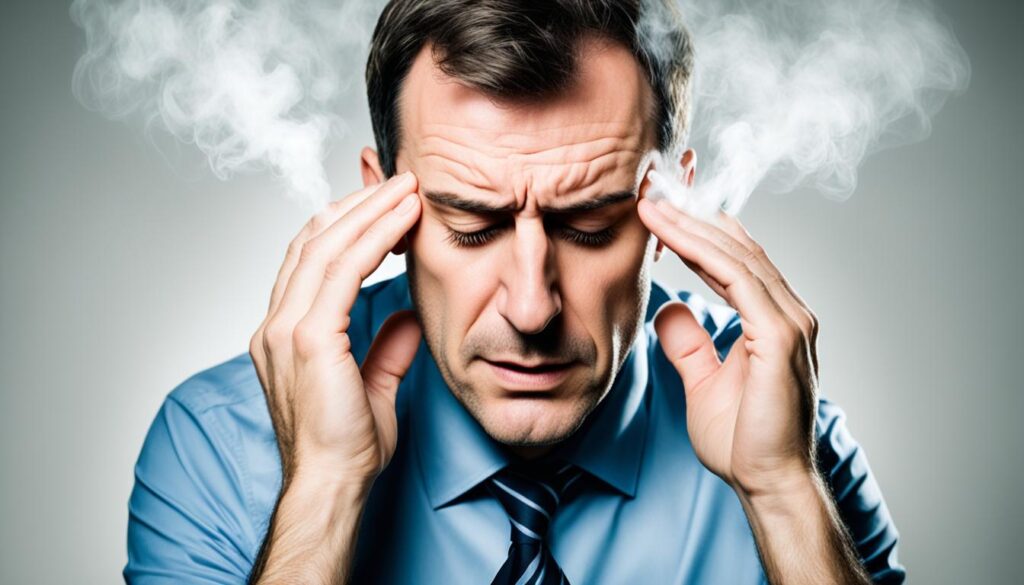
| Common Strong Smells | Potential Trigger Level* |
|---|---|
| Nail polish and nail polish remover | Medium |
| Perfumes and colognes | Low |
| Cleaning products | Medium |
| Cigarette smoke | Medium |
| Pet odors | Low |
*Potential Trigger Level:
- Low: Unlikely to trigger cluster headache attacks for most individuals.
- Medium: May trigger cluster headache attacks for some individuals.
- High: Likely to trigger cluster headache attacks for most individuals.
High Altitudes
High altitudes can have a significant impact on cluster headache attacks. When venturing to higher elevations, such as mountains or high-altitude regions, individuals with cluster headaches may experience a trigger or worsening of their symptoms. This connection between cluster headaches and high altitudes is believed to be linked to the dilation of blood vessels in the brain.
As oxygen levels decrease at higher altitudes, the body compensates by increasing blood vessel dilation in an attempt to deliver more oxygen to the brain. However, this dilation can lead to a cluster headache episode due to the heightened sensitivity of the blood vessels to pain and inflammation. The exact mechanism behind this relationship is still being studied, but it is believed that the interaction between oxygen levels, blood flow, and neurochemical changes in the brain contributes to the development of cluster headaches in high altitudes.
Experiencing cluster headaches at high altitudes can be incredibly challenging as it may limit activities and the enjoyment of natural landscapes. If you're planning to travel to a high-altitude area and have a history of cluster headaches, it's essential to be aware of this potential trigger. Taking preventive measures, such as consulting with your healthcare provider, ensuring adequate hydration, and managing stress levels, can help minimize the risk of cluster headache attacks while at high altitudes.
To better understand the relationship between high altitudes and cluster headache attacks, let's take a look at a comparative table highlighting key factors:
| Factors | High Altitudes | Low Altitudes |
|---|---|---|
| Oxygen Levels | Decreased | Normal |
| Blood Vessel Dilation | Increased | Normal |
| Cluster Headache Risk | Higher | Lower |
As shown in the table above, high altitudes tend to have decreased oxygen levels and increased blood vessel dilation, which can elevate the risk of cluster headache attacks. This emphasizes the importance of considering altitude factors when managing and preventing cluster headaches.
Weather Changes
For individuals living with cluster headaches, weather changes can have a significant impact on the frequency and intensity of their headaches. Many people with cluster headaches have reported that specific aspects of the weather can trigger or worsen their headache attacks. Some of these weather-related triggers include changes in barometric pressure, low barometric pressure, seasonal changes, high humidity, and rainfall.
Changes in barometric pressure, which refers to the pressure exerted by the atmosphere, can affect the body's internal pressure and can potentially trigger a cluster headache attack. Low barometric pressure, commonly associated with storms or weather fronts, has been particularly linked to an increased risk of headache attacks among individuals with cluster headaches.
In addition to changes in pressure, seasonal changes and variations in humidity levels have also been identified as possible triggers for cluster headaches. It is believed that these weather-related factors may disrupt the body's internal balance and contribute to the onset of headaches.
While the precise mechanisms by which weather changes impact cluster headaches remain unclear, it is important for individuals with cluster headaches to be aware of their personal triggers and take necessary precautions during periods of adverse weather conditions. By understanding the potential impact of weather on their headaches, individuals can better manage their condition and seek appropriate treatment.
FAQ
What are the common triggers for cluster headaches?
Common triggers for cluster headaches include alcohol, smoking, certain foods, time of day, time of year, bright lights, sleep problems, strong smells, high altitudes, weather changes, exercise, and stress.
How does alcohol trigger cluster headaches?
Alcohol is one of the most common triggers for cluster headaches. Many people with cluster headaches find that alcohol consumption can lead to an attack. There is no evidence to suggest that any specific type of alcohol is worse than others in triggering cluster headaches.
What is the relationship between smoking and cluster headaches?
There is a known relationship between cluster headache and tobacco use. As many as 88% of people with cluster headaches are smokers. Spending time in a smokey environment or being exposed to smoke may also trigger an attack.
How does time of day affect cluster headaches?
Cluster headache attacks frequently occur on a set schedule, often at night. This has led to them being referred to as "alarm clock headaches." Research suggests that cluster headaches are related to the circadian rhythm, which is regulated by the hypothalamus in the brain.
Do cluster headaches have a seasonal pattern?
Cluster headache attacks tend to occur in a pattern, with frequent attacks over a period of weeks or months followed by remission periods. The first attack in a cluster often occurs around the same time of year for an individual, either annually or every few years.
Can diet trigger cluster headache attacks?
Certain foods are more likely to trigger cluster headache attacks. These can include monosodium glutamates (MSG), nitrites or other preservatives, caffeine, aged cheese, tyramine, aspartame and other artificial sweeteners, and processed foods. Fasting, missing a meal, or dehydration can also trigger attacks.
How do bright lights impact cluster headaches?
Some individuals with cluster headaches experience sensitivity to bright or flashing lights. This sensitivity, known as photophobia, can trigger or worsen a cluster headache attack. Specific color wavelengths, such as blue-green, may also play a role in photophobia.
How are cluster headaches linked to sleep problems?
Cluster headaches may be affected by sleep cycles and circadian rhythms. Lack of sleep or changes in sleep patterns can trigger a cluster headache attack. Research has also shown a connection between cluster headache and sleep apnea, with a high percentage of people with cluster headache also experiencing sleep apnea.
Can strong smells trigger cluster headaches?
Some individuals report that strong smells, such as nail polish, can trigger a cluster headache attack. However, there is no definitive research to confirm specific scents as triggers for headaches.
How do high altitudes affect cluster headaches?
High altitudes may trigger or worsen cluster headache attacks. It is believed that the decrease in oxygen levels at higher altitudes leads to increased blood vessel dilation in the brain, which can trigger headaches.
Do weather changes impact cluster headaches?
Many people with cluster headaches report that weather changes can trigger or worsen their headaches. Specific aspects of the weather, such as changes in barometric pressure, low barometric pressure, seasonal changes, high humidity, and rainfall, have been mentioned as possible triggers.
Source Links
- https://my.clevelandclinic.org/health/diseases/5003-cluster-headaches
- https://www.healthline.com/health/headache/cluster-headache-triggers-list
- https://www.hopkinsmedicine.org/health/conditions-and-diseases/headache/cluster-headaches
Understanding Traumatic Encephalopathy Syndrome
Welcome to our article on Traumatic Encephalopathy Syndrome, a rare brain disorder that is caused by repeated head injuries. Also known as Chronic Traumatic Encephalopathy (CTE), this condition is characterized by the degeneration of nerve cells in the brain and worsens over time.
CTE is not related to a single head injury but rather to the accumulation of multiple head injuries, commonly seen in contact sports and military combat. It is often associated with a condition called Second Impact Syndrome, where a second head injury occurs before the symptoms of a previous head injury have fully resolved.
The exact mechanisms by which repeated head injuries contribute to the changes in the brain that lead to CTE are still being studied. However, it has been found that CTE is present in the brains of individuals who have participated in contact sports like American football, boxing, and military members who have been exposed to explosive blasts.
The symptoms of CTE include cognitive impairment, behavioral changes, mood disorders, and motor symptoms. It is important to note that CTE cannot be definitively diagnosed until after death through a brain autopsy. Currently, there are no validated diagnostic biomarkers for CTE, and there is no cure for the condition.
Symptoms of Traumatic Encephalopathy Syndrome
The symptoms of Traumatic Encephalopathy Syndrome (CTE) can vary and may not be specific to the condition. Some of the common symptoms reported in individuals with CTE include:
- Cognitive impairment: trouble thinking, memory loss, difficulties with planning and organization
- Behavioral changes: impulsive behavior, aggression
- Mood disorders: depression, apathy, emotional instability, substance misuse
- Motor symptoms: problems with walking and balance, parkinsonism (shaking, slow movement, trouble with speech), motor neuron disease (loss of walking, speaking, swallowing, and breathing control)
It is important to note that the symptoms of CTE do not typically develop immediately after a head injury but rather over years or decades after repeated head trauma. The exact progression of symptoms and the full range of signs associated with CTE are still not fully understood.

If you or someone you know is experiencing any of these symptoms after a history of head injuries, it is crucial to seek medical attention for an accurate diagnosis and appropriate management.
Diagnosing Traumatic Encephalopathy Syndrome
Diagnosing Traumatic Encephalopathy Syndrome (CTE) can be challenging as it cannot be definitively diagnosed until after death through a brain autopsy. However, in individuals with high-risk exposures, such as participation in high-contact sports or military combat, health care providers may diagnose traumatic encephalopathy syndrome when symptoms associated with CTE are present.
Difficult Diagnosis
Currently, researchers are working on developing diagnostic biomarkers for CTE, but none have been validated yet. While there is no definitive test for CTE during a person's lifetime, certain imaging techniques like positron emission tomography (PET) scans and functional magnetic resonance imaging (fMRI) can help in assessing brain abnormalities and ruling out other conditions. However, these methods still need further research and validation.
High-Risk Exposures
It is important for individuals experiencing symptoms associated with CTE, such as cognitive impairment, mood disorders, or motor symptoms, to seek medical attention. If you have been exposed to high-risk activities like contact sports or military combat and are experiencing such symptoms, it is crucial to discuss your concerns with a healthcare professional who specializes in neurological disorders.
If you or someone you know is experiencing thoughts of self-harm or suicide, it is essential to seek immediate help. Please call emergency services or a suicide hotline for immediate assistance. Remember, you are not alone, and there are resources available to support you.
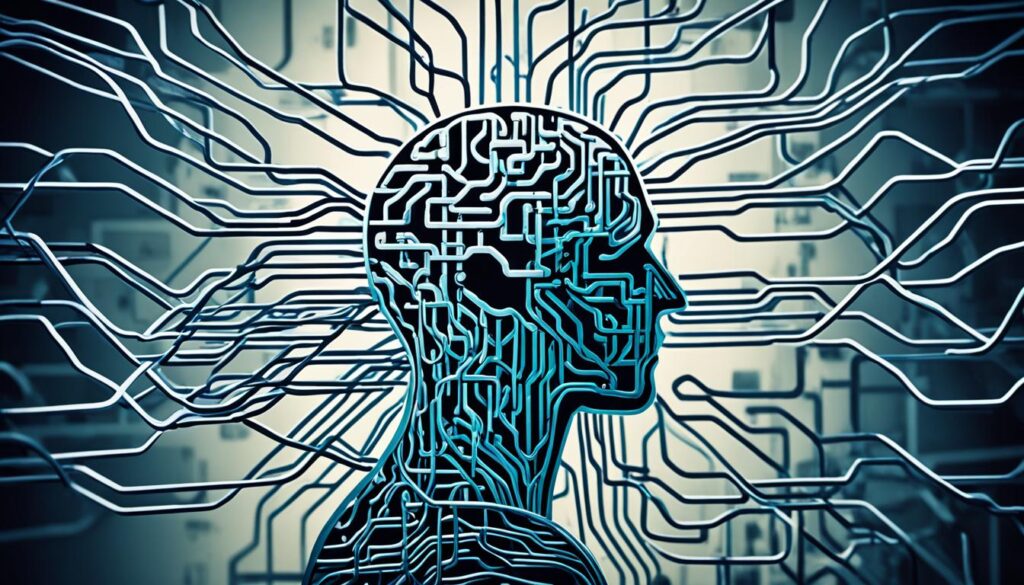
Causes and Risk Factors of Traumatic Encephalopathy Syndrome
Repeated head injuries, particularly those resulting in concussions, are the primary cause of Traumatic Encephalopathy Syndrome (CTE). Activities such as contact sports like American football, boxing, and hockey, as well as military combat, carry a higher risk of CTE due to the frequency of head injuries involved. Ongoing research is focused on understanding the exact mechanisms by which repeated head injuries contribute to the development of CTE.
Experts believe that the accumulation of head injuries leads to the deposition of a protein called tau around blood vessels in the brain. This deposition causes the degeneration of cells and the progression of the disease. While the exact process is still being studied, it is clear that repeated head injuries play a significant role in the development of CTE.
In addition to repeated head injuries, there may be genetic risk factors that increase an individual's susceptibility to CTE. One such genetic risk factor is the presence of the Apolipoprotein E (ApoE) e4 allele. Individuals with this allele are believed to have a higher risk of developing CTE after repeated head injuries.
To summarize:
- Repeated head injuries, particularly concussions, are the primary cause of Traumatic Encephalopathy Syndrome (CTE).
- Contact sports and military combat carry a higher risk of CTE due to the frequency of head injuries involved.
- The accumulation of head injuries leads to the deposition of a protein called tau around blood vessels in the brain, causing cell degeneration and the progression of CTE.
- Genetic risk factors, such as the Apolipoprotein E (ApoE) e4 allele, may increase an individual's susceptibility to CTE.
Understanding the causes and risk factors of CTE is crucial for the prevention, early detection, and effective management of this debilitating condition.

Conclusion
Traumatic Encephalopathy Syndrome (CTE) is a rare brain disorder that can have devastating effects on individuals who have experienced repeated head injuries, especially those involved in contact sports or military combat. The symptoms of CTE, including cognitive impairment, behavioral changes, mood disorders, and motor symptoms, can significantly impact an individual's quality of life.
Unfortunately, the definitive diagnosis of CTE can only be made posthumously through a brain autopsy, and there are currently no validated diagnostic biomarkers available. This underscores the importance of recognizing the signs and seeking medical attention if you or someone you know has a history of head injuries and is exhibiting symptoms associated with CTE.
Research into the causes and risk factors of CTE is ongoing, but it is clear that repeated head injuries, particularly concussions, play a significant role in its development. Therefore, taking preventative measures to reduce the number of head injuries and promptly treating concussions is crucial in mitigating the risk of CTE.
It is essential to prioritize the well-being of individuals who have experienced head injuries and to raise awareness about the potential long-term effects of traumatic encephalopathy syndrome. By doing so, we can work towards better understanding, prevention, and treatment of this debilitating brain disorder.
FAQ
What is Traumatic Encephalopathy Syndrome?
Traumatic Encephalopathy Syndrome, also known as Chronic Traumatic Encephalopathy (CTE), is a rare brain disorder that is caused by repeated head injuries. It is characterized by the degeneration of nerve cells in the brain and worsens over time.
What are the symptoms of Traumatic Encephalopathy Syndrome?
The symptoms of Traumatic Encephalopathy Syndrome (CTE) can vary and may not be specific to the condition. Some of the common symptoms reported include cognitive impairment, behavioral changes, mood disorders, and motor symptoms.
How is Traumatic Encephalopathy Syndrome diagnosed?
Diagnosing Traumatic Encephalopathy Syndrome (CTE) can be challenging as it cannot be definitively diagnosed until after death through a brain autopsy. However, health care providers may diagnose traumatic encephalopathy syndrome in individuals with high-risk exposures and when symptoms associated with CTE are present.
What are the causes and risk factors of Traumatic Encephalopathy Syndrome?
The primary cause of Traumatic Encephalopathy Syndrome is repeated head injuries, particularly those that result in concussions. Contact sports like American football, boxing, and hockey, as well as military combat, are associated with a higher risk of CTE due to the frequency of head injuries in these activities. There may also be genetic risk factors, such as the Apolipoprotein E (ApoE) e4 allele, that can increase an individual's susceptibility to CTE.
Is there a cure for Traumatic Encephalopathy Syndrome?
Currently, there is no cure for Traumatic Encephalopathy Syndrome. It is important for individuals experiencing symptoms associated with CTE to seek medical attention for symptom management and support.
Source Links
- https://www.mayoclinic.org/diseases-conditions/chronic-traumatic-encephalopathy/symptoms-causes/syc-20370921
- https://www.ncbi.nlm.nih.gov/books/NBK470535/
- https://www.nature.com/articles/s41582-021-00500-0
Cerebral Traumatic Encephalopathy: A Guide
Cerebral traumatic encephalopathy (CTE) is characterized by the progressive buildup of a protein called tau in the brain, leading to damage in various areas. The exact cause of CTE is still unknown, but it is believed to be associated with repeated head injuries. Symptoms may not manifest until years or even decades after the last brain injury.
In this guide, we will explore the causes, progression, and symptoms of cerebral traumatic encephalopathy. We will also discuss coping strategies and management techniques to help you navigate life with CTE.
By understanding the impact of CTE and implementing appropriate coping strategies, you can improve your quality of life and overall well-being. Let's dive into this guide to learn more about this condition and how to effectively manage it.
Causes and Progression of Cerebral Traumatic Encephalopathy
The exact causes of CTE are not fully understood, but research suggests that repeated head injuries, including concussions and traumatic brain injury, can contribute to its development. These injuries disrupt the normal functioning of the brain and trigger a cascade of events that lead to the formation and accumulation of tau protein.
Tau protein is a crucial component of nerve cells, providing structural support and aiding in the transport of nutrients and other essential substances. In CTE, tau proteins become abnormally phosphorylated, causing them to clump together and form tangles. These tangles disrupt the normal communication between brain cells, leading to their dysfunction and eventual death.

The progression of CTE varies from person to person. Initially, the tau protein buildup is localized in specific regions of the brain. However, over time, the accumulation spreads, affecting larger areas and causing shrinkage in those regions. This progressive damage can result in a range of cognitive, emotional, and behavioral symptoms.
Risk Factors for CTE
| Factors | Description |
|---|---|
| Repetitive Head Injuries | Multiple concussions or traumatic brain injuries increase the risk of developing CTE. |
| Duration of Exposure | Long-term participation in contact sports or military combat can elevate the risk of developing CTE. |
| Genetics | Although not fully understood, certain genetic factors may make individuals more susceptible to CTE. |
| Age of First Exposure | Early exposure to head injuries, especially before the brain is fully developed, may increase the likelihood of developing CTE. |
It is important to note that not everyone who experiences head injuries will develop CTE. The exact interplay between genetic, environmental, and individual factors that contribute to the development and progression of CTE is still being explored.
Symptoms of Cerebral Traumatic Encephalopathy
CTE, also known as cerebral traumatic encephalopathy, can present with various symptoms that can impact an individual's daily life. Common CTE symptoms include:
- Memory loss
- Difficulty concentrating
- Behavioral changes
- Personality changes
- Speech difficulties
In the early stages of CTE, these symptoms may be mild and go unnoticed by both the affected person and their family. These early symptoms can include:
- Mild memory loss
- Headaches
- Irritability
- Slurred speech
- Unsteadiness when walking
As CTE progresses, the symptoms may worsen, affecting various aspects of a person's life:
- Memory problems intensify, making it difficult to recall recent events or information.
- Mood swings and behavioral changes become more apparent, leading to increased irritability, impulsivity, and aggression.
- Difficulties with speech and language develop, resulting in slurred speech or difficulty finding the right words.
- Depression, anxiety, and social difficulties become more prevalent.
- Balance and coordination may deteriorate, increasing the risk of falls and accidents.
Understanding these symptoms is crucial in recognizing the presence of CTE and seeking appropriate medical support. If you or someone you know experience any of these symptoms, consult with a healthcare professional for a proper evaluation and guidance.

Managing Cerebral Traumatic Encephalopathy
Currently, there is no cure for CTE. However, you can work with healthcare providers to manage your symptoms and improve your quality of life. Treatment options may include medications to address specific symptoms such as depression or anxiety.
Cognitive rehabilitation and therapy can help you cope with memory and thinking difficulties. These interventions focus on improving cognitive function, memory retention, and problem-solving skills.
Lifestyle adaptations play a crucial role in managing CTE. Here are some lifestyle changes that can be beneficial:
- Maintain a regular sleep schedule: Getting enough restful sleep is essential for brain health and overall well-being. Aim for 7-9 hours of sleep per night and establish a consistent bedtime routine.
- Engage in regular exercise: Physical activity has numerous benefits for brain health. Regular exercise can improve blood flow to the brain, promote the growth of new neurons, and enhance cognitive function.
- Avoid activities that may cause additional head injuries: Minimize participation in activities with a high risk of head injuries, such as contact sports or activities with a high probability of falls. Protect your head by wearing appropriate safety gear, such as helmets.
Creating a supportive network of family and friends is crucial when managing the challenges of living with CTE. Seek emotional support from loved ones who can provide understanding and encouragement throughout your journey. Joining support groups or attending counseling sessions can also help you navigate the emotional impact of CTE.
Remember, managing CTE requires a comprehensive approach that includes medical support, lifestyle adaptations, and emotional well-being. By implementing these strategies, you can optimize your quality of life and cultivate resilience in the face of this condition.

Conclusion
Cerebral traumatic encephalopathy (CTE) is a complex condition with a profound impact on the lives of those affected. While there is ongoing research into the exact causes and progression of CTE, raising awareness about the condition and its potential risk factors is crucial. Understanding the symptoms and seeking appropriate medical support are important steps for individuals with CTE to manage their symptoms and receive the necessary support.
Coping strategies play a vital role in enhancing the quality of life and well-being of individuals with CTE. Implementing lifestyle adaptations, such as maintaining a regular sleep schedule and engaging in regular exercise, can help manage the symptoms of CTE. Additionally, avoiding activities that may cause additional head injuries is essential to reduce the risk of further damage.
Open and honest conversations about future care preferences are crucial for individuals with CTE and their loved ones. By discussing and planning for future needs, individuals can ensure they receive the necessary support and care as the condition progresses. Creating a strong network of family and friends, as well as seeking emotional support, can provide invaluable assistance in coping with the challenges of living with CTE.
FAQ
What is cerebral traumatic encephalopathy (CTE)?
Cerebral traumatic encephalopathy is a condition that can result from head injuries, particularly in athletes involved in contact sports like boxing or football and combat veterans. It is characterized by the progressive buildup of a protein called tau in the brain, leading to damage in various areas.
What are the causes of CTE?
The exact causes of CTE are not fully understood, but research suggests that repeated head injuries, including concussions and traumatic brain injury, can contribute to its development.
What are the symptoms of CTE?
Common symptoms of CTE include issues with memory, concentration, behavior, personality changes, and speech difficulties. Early symptoms may be mild and go unnoticed, but as the disease progresses, memory, mood, behavior, and speech problems may worsen.
Can CTE be cured?
Currently, there is no cure for CTE. However, individuals with CTE can work with healthcare providers to manage their symptoms and improve their quality of life.
How can CTE be managed?
Treatment options for managing CTE may include medications to address specific symptoms, cognitive rehabilitation and therapy, and lifestyle adaptations such as maintaining regular sleep and exercise routines, and avoiding activities that may cause additional head injuries.
Source Links
- https://my.clevelandclinic.org/health/diseases/17686-chronic-traumatic-encephalopathy-cte
- https://memory.ucsf.edu/sites/memory.ucsf.edu/files/wysiwyg/UCSF Dementia Patient Guide_CTE_11-3-17.pdf
- https://www.ncbi.nlm.nih.gov/pmc/articles/PMC8069746/
Chronic Cluster Headaches: Symptoms & Relief
Chronic cluster headaches are characterized by a specific type of pain and a pattern of attacks. The pain is intense and usually centered around one side of the head, often around the eye area. Other symptoms may include watery eyes, eye redness, a droopy eyelid, a runny or stuffy nostril, and flushing or sweating.
Diagnosing cluster headaches involves describing the pain, its location, severity, and other accompanying symptoms. A neurologist usually makes the diagnosis through a medical history review, physical and neurological examination. Tests such as MRI and CT scans may be done to rule out other possible causes of the pain.
The goal of treatment is to alleviate pain, reduce the duration of headache periods, and prevent new attacks. Fast-acting treatments like oxygen therapy, triptans, octreotide, local anesthetics, and dihydroergotamine can provide relief during an active attack. Preventive treatments, on the other hand, can reduce the frequency and intensity of cluster headaches and may involve medications such as verapamil, corticosteroids, galcanezumab, lithium, and noninvasive vagus nerve stimulation.
It's important to note that lifestyle and home remedies can also play a role in managing cluster headaches. Stick to a regular sleep schedule, avoid alcohol, and consider alternative medicine approaches like melatonin and capsaicin, although it's advisable to consult with a healthcare provider before trying any alternative treatments.
Coping with cluster headaches can be challenging, but know that you're not alone. Seeking support from a counselor, therapist, or joining a headache support group can provide the emotional and practical assistance you need. Keeping a headache diary and preparing for medical appointments can also help in the diagnostic process and ensure you get the best possible care.
Stay tuned for the next sections of this article, where I'll dive deeper into cluster headache diagnosis, treatment options, potential surgical interventions, and promising future advancements. Together, we can find the relief and support you deserve.
Diagnosis of Cluster Headaches
Diagnosing cluster headaches involves a comprehensive evaluation of the patient's medical history, symptoms description, and a thorough physical and neurological examination. A specialist, typically a neurologist trained in treating headaches, plays a vital role in making an accurate diagnosis.
In some cases, additional tests may be required to rule out other potential causes of the pain. These tests include:
- MRI scan: Magnetic Resonance Imaging (MRI) uses magnetic fields and radio waves to produce detailed images of the brain, allowing healthcare providers to identify any abnormalities or structural issues that may be contributing to the cluster headaches.
- CT scan: Computed Tomography (CT) scan uses X-rays to create cross-sectional images of the brain, providing further insights into possible causes of the pain.
By utilizing these tests, healthcare providers can effectively distinguish cluster headaches from other conditions such as tumors, infections, strokes, and neurological disorders.
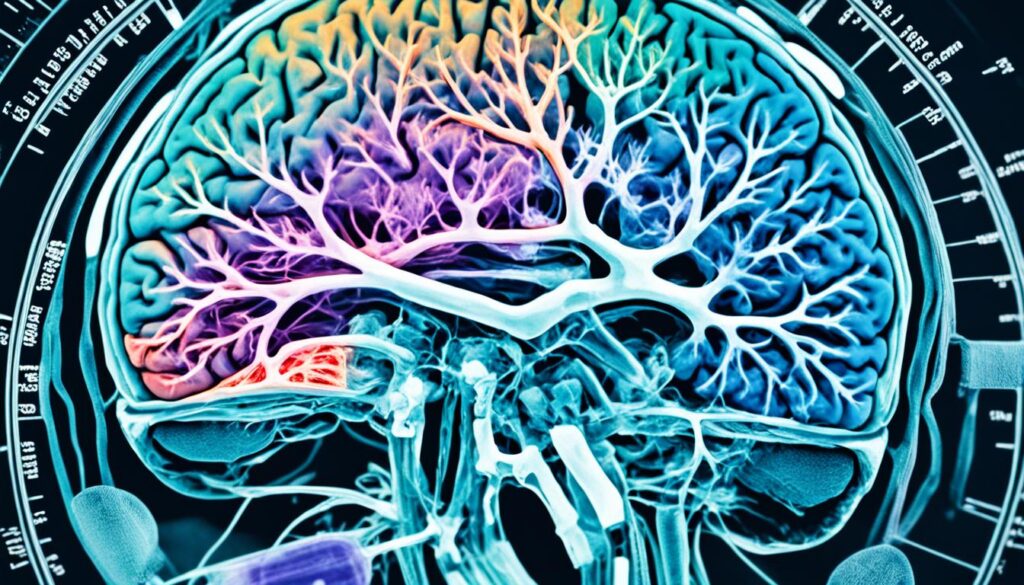
Understanding Neurological Examination
During the neurological examination, the healthcare provider assesses various aspects of the nervous system to gather more information about the cluster headaches. This examination may include:
- Checking for abnormalities in reflexes, coordination, and muscle strength.
- Evaluating sensory functions such as touch, temperature, and pain perception.
- Assessing cranial nerves, which control various facial movements and sensations.
- Observing eye movements and visual fields.
These assessments help the healthcare provider to gain a comprehensive understanding of the patient's condition and make an accurate diagnosis.
Treatment Options for Cluster Headaches
When it comes to treating cluster headaches, the primary objective is to alleviate pain, shorten the duration of headache periods, and prevent the onset of new attacks. There are different treatment options available, including fast-acting treatments to stop a cluster headache that has already started, as well as preventive treatments to hinder attacks during the cluster period.
Fast-acting treatments are designed to provide immediate relief and can be effective for managing the intense pain of a cluster headache. Some of these treatments include:
- Oxygen therapy
- Triptans
- Octreotide
- Local anesthetics
- Dihydroergotamine
These fast-acting treatments work by targeting the underlying mechanisms of a cluster headache, helping to reduce pain and alleviate symptoms.
On the other hand, preventive treatments are intended to prevent attacks from occurring during the cluster period. These treatments are often initiated at the onset of the headache cycle and may involve the use of medications such as:
- Verapamil
- Corticosteroids
- Galcanezumab
- Lithium
- Noninvasive vagus nerve stimulation
- Nerve blocks
- Other preventive medications
These medications aim to regulate the underlying factors that contribute to cluster headaches, reducing the frequency and severity of attacks.
It is crucial to work closely with a healthcare provider to determine the most suitable treatment plan for individual cases. The healthcare provider will take into account factors such as the frequency and intensity of the headaches, as well as any underlying health conditions that may impact the choice of treatment.
| Treatment Type | Examples |
|---|---|
| Fast-Acting Treatments |
|
| Preventive Treatments |
|
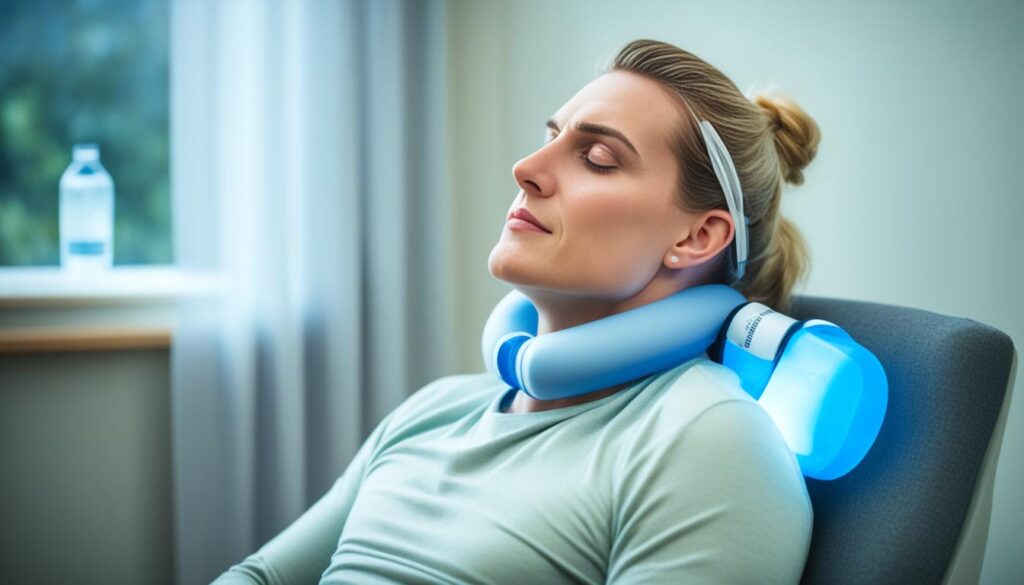
Working with a Healthcare Provider
When exploring treatment options for cluster headaches, it is important to collaborate with a trusted healthcare provider who specializes in headache management. They will guide you through the different treatment options, help you understand their benefits and potential side effects, and provide personalized recommendations based on your specific needs.
Additionally, they can monitor your progress, make adjustments to the treatment plan if necessary, and ensure that you have the support and information needed to effectively manage your cluster headaches.
By actively working with a healthcare provider, you can find relief from the symptoms of cluster headaches and improve your overall quality of life.
Surgical Options for Cluster Headaches
In rare cases where other treatments have not provided relief, surgery may be considered as an option for chronic cluster headaches. Surgical procedures aim to damage the nerve pathways that are believed to be causing the pain.
However, it is important to note that surgical interventions for cluster headaches are not commonly performed and are considered as a last resort. The long-term benefits of such surgeries are still uncertain, and there can be potential complications that arise.
Complications: One potential complication of cluster headache surgery is muscle weakness in the jaw, which may affect functions such as chewing. Additionally, there may be a risk of loss of feeling in certain areas of the face and head.
To provide a comprehensive overview, here is a table summarizing the potential benefits and complications of cluster headache surgery:
| Benefits | Complications |
|---|---|
|
|
It is essential for individuals considering cluster headache surgery to have a thorough discussion with their healthcare provider. The potential benefits and risks of surgery should be carefully evaluated and weighed against other treatment options that may be available.

Potential Future Treatments for Cluster Headaches
As researchers delve deeper into understanding cluster headaches, they are exploring innovative treatments that offer hope for the future. One promising avenue of research involves nerve stimulation procedures that target specific areas of the brain. These procedures aim to interrupt pain signals and provide relief for individuals suffering from cluster headaches.
One such procedure is sphenopalatine ganglion stimulation. This involves the placement of a device near the sphenopalatine ganglion, a cluster of nerve cells located behind the nose. By stimulating this area, researchers hope to alleviate cluster headache symptoms and reduce the frequency of attacks.
Another potential treatment is occipital nerve stimulation. Here, a device is implanted near the occipital nerves, which are responsible for transmitting pain signals from the back of the head to the brain. By modulating these nerves, researchers aim to provide long-term relief from cluster headache pain.
The concept of deep brain stimulation is also being explored for cluster headache treatment. This procedure involves placing electrodes deep within the brain to target specific areas that are involved in pain processing. By stimulating these areas, researchers hope to interrupt the pain signals and provide relief for individuals with cluster headaches.
While these procedures show promise in the treatment of cluster headaches, further research is needed to fully understand their efficacy, safety, and potential benefits. Ongoing studies are being conducted to gather more data and determine their place in the comprehensive management of cluster headaches.
Lifestyle and Home Remedies for Cluster Headaches
Along with medical treatments, making certain lifestyle changes and trying home remedies can be beneficial in managing cluster headaches. These lifestyle modifications and alternative treatments can help reduce the frequency and intensity of cluster headache attacks, providing some relief from the debilitating pain.
Maintain a Regular Sleep Schedule
One important lifestyle change that can help manage cluster headaches is maintaining a consistent sleep schedule. Establishing a regular sleep routine and ensuring an adequate amount of sleep can help regulate your body's internal clock and prevent triggers that can lead to cluster headache attacks. It is recommended to aim for 7-8 hours of quality sleep every night.
Avoid Alcohol
Alcohol consumption is a common trigger for cluster headaches. If you experience cluster headaches, it is advisable to avoid alcohol completely, as it can provoke and intensify headache attacks. Alcohol can disrupt your sleep patterns and trigger hormonal fluctuations, both of which can contribute to the onset of cluster headaches.
Explore Alternative Treatments
While medical treatments are essential, alternative treatments can also be explored in managing cluster headaches. Two alternative treatments that may provide relief for some individuals are melatonin and capsaicin.
- Melatonin: Melatonin is a hormone that helps regulate the body's internal clock. Taking melatonin supplements under the guidance of a healthcare provider may help improve sleep patterns and potentially reduce the frequency of cluster headache attacks.
- Capsaicin: Capsaicin is a chemical found in chili peppers that is known to have pain-relieving properties. Applying capsaicin cream or ointment to the affected area, such as the temple or forehead, may provide temporary relief from cluster headache pain. However, it is important to consult with a healthcare provider before using capsaicin to ensure it is safe for you.
It is important to note that the effectiveness of these alternative treatments can vary from person to person. What works for one individual may not work for another, so it is essential to consult with a healthcare provider before trying any alternative treatment.
Coping with cluster headaches can be challenging, both physically and emotionally. Seeking support from a counselor, therapist, or joining a headache support group can provide valuable emotional and practical assistance in dealing with the impact of cluster headaches on daily life.

Complications and Impact of Cluster Headaches
Living with cluster headaches can have a profound impact on a person's daily functioning and overall quality of life. The intense pain and high frequency of attacks can disrupt work productivity, strain relationships, and limit one's ability to participate in social activities.
The severity of cluster headaches has earned them the nickname "suicide headaches" due to the extreme pain experienced during an episode. This excruciating pain can lead to feelings of hopelessness, frustration, and even depression. It is not uncommon for individuals with cluster headaches to struggle with their mental health, experiencing symptoms such as sadness, loss of interest in activities, and difficulties concentrating.
In rare cases, individuals with cluster headaches may develop suicidal thoughts as a result of the chronic pain and its impact on their daily lives. If you or someone you know is experiencing significant emotional distress or having thoughts of self-harm, it is crucial to seek immediate medical help and support.
Healthcare providers who specialize in headache disorders can offer effective treatments and resources to manage the impact of cluster headaches. They can provide guidance on medication options, lifestyle modifications, and coping techniques to alleviate the symptoms and improve overall well-being.
Support from healthcare providers, therapists, and support groups can be instrumental in helping individuals navigate the challenges of living with cluster headaches. They can offer emotional support, provide coping strategies, and connect individuals with valuable resources.
Impact on Daily Functioning
Cluster headaches can significantly disrupt daily functioning and limit a person's ability to carry out routine tasks. The pain attacks are often intense and can be debilitating, making it difficult to concentrate, work, or engage in social activities. The unpredictability and frequency of the attacks may lead to frequent absences from work or school, potentially affecting one's professional and academic performance.
The impact on daily functioning also extends to personal relationships. The physical and emotional toll of cluster headaches can strain relationships with family members, friends, and romantic partners. It may be challenging to maintain social connections and fulfill social obligations due to the disruptive nature of the headaches.
Managing Depression and Emotional Impact
Living with chronic pain and the constant fear of an impending cluster headache attack can take a toll on mental health. Depression is a common comorbidity among individuals with cluster headaches. It is essential to address and manage both the physical and emotional aspects of the condition.
Healthcare providers can recommend therapy options, such as cognitive-behavioral therapy (CBT), to help individuals develop effective coping mechanisms, manage stress, and improve their overall well-being. Support groups and online communities can also provide a platform for individuals to connect with others who understand their struggles and find a sense of validation and support.
Preventing Suicidal Thoughts
If someone with cluster headaches is experiencing suicidal thoughts, it is critical to seek immediate help. Contact a healthcare provider, call a helpline, or go to the nearest emergency room. Suicidal thoughts should never be ignored or underestimated, and support is available to help individuals through crisis situations.
It is important for individuals with cluster headaches to have a support network in place. This can involve loved ones, healthcare providers, therapists, and support groups who can offer guidance, understanding, and practical assistance to navigate through difficult times.
If you or someone you know is experiencing significant emotional distress or having thoughts of self-harm, do not hesitate to reach out for help. You are not alone, and there are resources available to support you.
| Impact of Cluster Headaches | Effects |
|---|---|
| Work and Productivity | Cluster headaches can significantly affect work performance and productivity, often leading to frequent absences and difficulty concentrating. |
| Social Life and Relationships | The disruptive nature of cluster headaches can strain personal relationships and limit social activities, often leading to feelings of isolation. |
| Mental Health | The intense pain and chronic nature of cluster headaches can contribute to depression, anxiety, and other mental health challenges. |
| Suicidal Thoughts | In rare cases, individuals with cluster headaches may experience suicidal thoughts due to the severity of the pain and its impact on daily life. |
Seeking Medical Help for Cluster Headaches
If you're experiencing cluster headaches or notice a change in your headache symptoms, it's crucial to seek medical help. You may start by making an appointment with your primary care provider, who can assess your symptoms and provide initial guidance. Depending on the severity and complexity of your condition, they may refer you to a neurologist for further evaluation and specialized care.
To make the most of your medical appointment, it's helpful to keep a headache diary. This diary should track the frequency, duration, and potential triggers of your headaches. By documenting this information, you can provide valuable insights to your healthcare provider, aiding in the diagnostic process and treatment planning.
During your appointment, it's important to come prepared with a list of questions to ask your healthcare provider. This will ensure that all of your concerns are addressed and that you have a clear understanding of your diagnosis and treatment options. Consider discussing the following:
- The potential causes and triggers of your cluster headaches
- The available treatment options and their effectiveness
- Potential side effects of medications or procedures
- Recommendations for managing cluster headaches at home
- Strategies for coping with the impact of cluster headaches on your daily life
Bringing a family member or friend to accompany you to the appointment can provide additional support and help you remember the information discussed. They can also offer emotional support during what can be a challenging and overwhelming time.
Remember, seeking medical help for your cluster headaches is an important step towards finding relief and improving your quality of life. Your healthcare provider is your ally in this journey and can provide the expert guidance and support you need.
Symptoms, Causes, and Risk Factors of Cluster Headaches
Cluster headaches are characterized by severe pain on one side of the head, often around the eye area. Other common symptoms include watery eyes, eye redness, droopy eyelid, runny or stuffy nostril, and flushing or sweating.
The exact cause of cluster headaches is unknown, but experts believe it may involve the hypothalamus, an area of the brain that regulates the body's biological clock.
Triggers for cluster headaches can vary, but common ones include alcohol consumption, bright lights, hot temperatures, certain foods with nitrites, and specific medications.
Risk factors for developing cluster headaches include being male, between the ages of 20 and 40, smoking, alcohol use, and a family history of cluster headaches.
Cluster Headache Symptoms, Causes, and Risk Factors
| Symptoms | Causes | Risk Factors |
|---|---|---|
| Severe pain on one side of the head | Hypothalamus involvement | Being male |
| Watery eyes | Between the ages of 20 and 40 | |
| Eye redness | Smoking | |
| Droopy eyelid | Alcohol use | |
| Runny or stuffy nostril | Family history of cluster headaches | |
| Flushing or sweating |
Conclusion
Living with chronic cluster headaches can be incredibly challenging and have a significant impact on daily life. However, with the right diagnosis and management strategies, individuals can find relief and improve their quality of life.
There are various treatment options available to manage chronic cluster headaches. Fast-acting medications such as oxygen therapy, triptans, octreotide, and local anesthetics can help alleviate pain during an attack. Preventive therapies like verapamil, corticosteroids, and noninvasive vagus nerve stimulation can help reduce the frequency and intensity of headache periods.
In rare cases where other treatments are ineffective, surgical interventions may be considered. These procedures aim to damage the nerve pathways believed to be causing the pain. While surgical options are not commonly performed and come with their own risks, they can offer relief for some individuals.
Seeking support from healthcare providers, counselors, and support groups is essential in managing chronic cluster headaches. These professionals can provide valuable guidance, emotional support, and help develop personalized management plans. Additionally, ongoing research and advancements in the field offer hope for future treatments and improved outcomes for individuals living with chronic cluster headaches.
FAQ
What are the symptoms of chronic cluster headaches?
Chronic cluster headaches are characterized by severe pain on one side of the head, often around the eye area. Other common symptoms include watery eyes, eye redness, droopy eyelid, runny or stuffy nostril, and flushing or sweating.
How are cluster headaches diagnosed?
Cluster headaches are diagnosed through a thorough evaluation of the patient's medical history, description of symptoms, and a physical and neurological examination. Additional tests such as MRI scans and CT scans may be done to rule out other potential causes of the pain.
What treatment options are available for cluster headaches?
Treatment options for cluster headaches include fast-acting treatments to stop a cluster headache once it starts, such as oxygen therapy, triptans, octreotide, local anesthetics, and dihydroergotamine. Preventive treatments are also used to stop attacks during the cluster period and may involve medications like verapamil, corticosteroids, galcanezumab, lithium, and noninvasive vagus nerve stimulation.
Are there surgical options for cluster headaches?
In rare cases where other treatments have not provided relief, surgery may be considered as an option for chronic cluster headaches. Surgical procedures aim to damage the nerve pathways that are believed to be causing the pain, but they are considered a last resort due to uncertainties about long-term benefits and potential complications.
Are there potential future treatments for cluster headaches?
Researchers are exploring potential future treatments for cluster headaches, including procedures such as sphenopalatine ganglion stimulation, occipital nerve stimulation, and deep brain stimulation. These procedures involve the placement of a device in specific areas of the brain to block pain signals. However, more research is needed to fully understand their efficacy and benefits.
Can lifestyle changes and home remedies help manage cluster headaches?
Yes, certain lifestyle changes and home remedies can help manage cluster headaches. Maintaining a regular sleep schedule and avoiding alcohol can be beneficial. Alternative treatments like melatonin and capsaicin may also provide relief, but it is important to consult with a healthcare provider before using them.
What are the complications and impact of cluster headaches?
Cluster headaches can significantly impact daily functioning and quality of life. The intense pain and frequency of attacks can interfere with work, relationships, and overall well-being. In rare cases, individuals may experience significant emotional distress or even thoughts of self-harm. Seeking support from healthcare providers, counselors, and support groups is crucial.
How can I seek medical help for cluster headaches?
If you are experiencing cluster headaches or a change in headache symptoms, it is important to seek medical help. Start by making an appointment with a primary care provider who may refer you to a neurologist for further evaluation. Keeping a headache diary and preparing a list of questions for your healthcare provider can be helpful in the diagnostic process.
What are the symptoms, causes, and risk factors of cluster headaches?
Cluster headaches are characterized by severe pain on one side of the head, often around the eye area. Triggers for cluster headaches can vary, but common ones include alcohol consumption, bright lights, hot temperatures, certain foods with nitrites, and specific medications. Risk factors for developing cluster headaches include being male, between the ages of 20 and 40, smoking, alcohol use, and a family history of cluster headaches.
What can I expect in managing chronic cluster headaches?
Chronic cluster headaches can be a debilitating condition, but with proper diagnosis, treatment, and support, individuals can find relief and improve their quality of life. Ongoing research and advancements in the field offer hope for future treatments and improved outcomes.
Source Links
- https://www.mayoclinic.org/diseases-conditions/cluster-headache/diagnosis-treatment/drc-20352084
- https://my.clevelandclinic.org/health/diseases/5003-cluster-headaches
- https://www.mayoclinic.org/diseases-conditions/cluster-headache/symptoms-causes/syc-20352080
Chronic Fatigue Syndrome Cure: New Insights
Welcome to our article on chronic fatigue syndrome (CFS) and the latest advancements in its treatment. If you or someone you know is affected by CFS, you're likely aware of the challenges it brings to daily life. But there is hope. Exciting new research has uncovered important discoveries that could pave the way for more effective treatments and potentially even a cure for CFS.
In a groundbreaking study conducted at the National Institutes of Health (NIH), researchers have identified significant differences in the brains and body systems of individuals with post-infectious CFS compared to those without the condition. These findings have shed light on potential mechanisms and therapeutic targets for CFS treatment.
The study revealed disruptions in the autonomic nervous system, heart and lung function, and brain activity in individuals with CFS. Additionally, differences in immune function, specifically in B cells, were observed. These findings suggest that CFS may be triggered by immune system dysfunction following infections, resulting in changes in the central nervous system and the development of symptoms.
These groundbreaking findings open up new avenues of research and provide renewed hope for finding effective treatments for CFS. By understanding the underlying mechanisms and potential therapeutic targets, researchers can now explore innovative approaches to alleviate symptoms and improve the quality of life for individuals with CFS.
Stay tuned as we delve further into the understanding of CFS in subsequent sections. We will discuss the symptoms, the role of infections, immune system abnormalities, and potential treatment approaches for managing and mitigating the impact of CFS on daily life.
Understanding Myalgic Encephalomyelitis/Chronic Fatigue Syndrome (ME/CFS)
Myalgic encephalomyelitis/chronic fatigue syndrome (ME/CFS) is a debilitating illness that affects millions of people worldwide. It is characterized by profound fatigue, exercise intolerance, and cognitive problems. This condition can develop after an infection, known as post-infectious ME/CFS (PI-ME/CFS).
The exact cause of ME/CFS is still unknown, which poses a significant challenge in developing effective treatments. However, researchers have made progress in understanding its symptoms and impact on daily life.
Common symptoms of ME/CFS include:
- Debilitating fatigue
- Brain fog
- Post-exertional malaise
ME/CFS symptoms often worsen after minimal exertion, making it difficult for individuals to carry out their daily activities. It significantly impacts their functioning and quality of life.

In the United States alone, ME/CFS affects over 4 million people. It is crucial to raise awareness about this condition and provide support for those who are affected.
| ME/CFS Symptoms | ME/CFS Impact |
|---|---|
| Profound fatigue | Difficulty carrying out daily activities |
| Exercise intolerance | Reduced physical capacity |
| Cognitive problems | Impaired concentration and memory |
Although there is currently no FDA-approved cure for ME/CFS, ongoing research aims to improve our understanding of this condition and develop effective treatments to alleviate its symptoms. A multidisciplinary approach that combines both pharmacological and non-pharmacological interventions is recommended for managing ME/CFS.
The next section will discuss the role of infections in ME/CFS and its implications for treatment.
The Role of Infections in ME/CFS
Infections, particularly herpesviruses like Epstein-Barr virus (EBV), have been associated with the development of ME/CFS. Studies have shown increased viral load and antibody titres to herpesviruses in ME/CFS patients. Reactivation of these viruses may contribute to immune system dysfunction and inflammation seen in ME/CFS.
Antiviral therapies such as acyclovir, valacyclovir, and valganciclovir have been used in clinical trials to target viral infections in ME/CFS patients. Immunomodulators like rintatolimod, which enhances the immune response, have also been tested. These treatments show promise in improving symptoms in some ME/CFS patients. Further research is needed to explore the role of infections and develop effective antiviral and immunomodulatory treatments for ME/CFS.
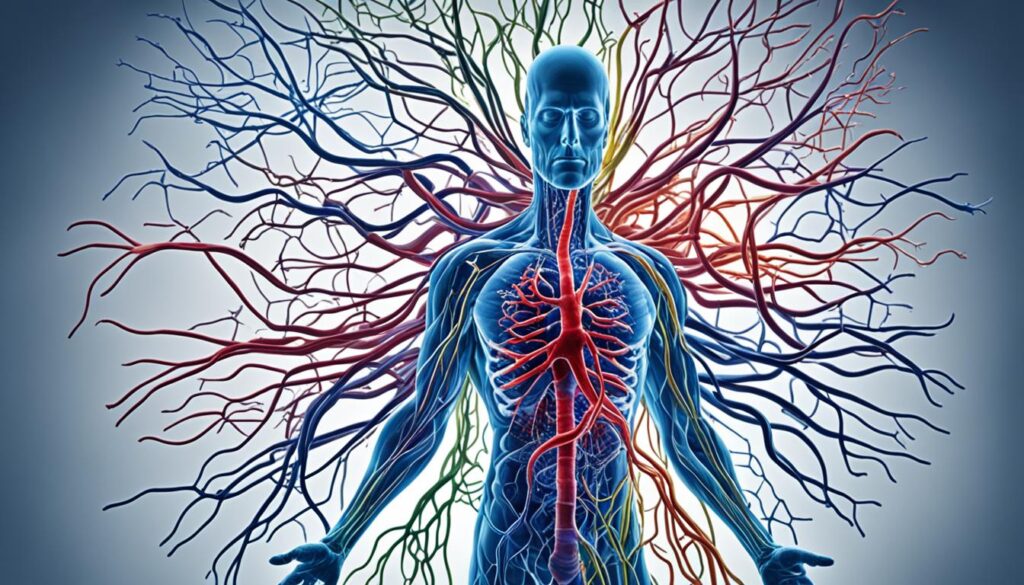
| Treatment | Description |
|---|---|
| Acyclovir | An antiviral medication that inhibits the replication of herpesviruses |
| Valacyclovir | A prodrug of acyclovir, converted to acyclovir in the body for sustained antiviral activity |
| Valganciclovir | An antiviral medication primarily used for the treatment of cytomegalovirus (CMV) infections |
| Rintatolimod | An immunomodulator that stimulates the immune response, potentially improving ME/CFS symptoms |
Immune System Abnormalities in ME/CFS
Myalgic encephalomyelitis/chronic fatigue syndrome (ME/CFS) is characterized by various immune system abnormalities that contribute to inflammation and immune dysregulation in affected individuals. These abnormalities include changes in cytokine profiles, alterations in B-cell subsets, and impaired natural killer (NK) and T cell function. Autoantibodies, indicating potential autoimmune involvement, are also detected in some ME/CFS patients.
One of the key immune system abnormalities observed in ME/CFS is the dysregulation of cytokine profiles. Cytokines are small proteins that play a crucial role in immune system communication. Studies have shown altered cytokine levels in ME/CFS patients, with both pro-inflammatory and anti-inflammatory cytokines being affected. This dysregulation contributes to the chronic inflammation and immune dysfunction characteristic of the condition.
In addition to cytokine abnormalities, ME/CFS is associated with changes in B-cell subsets. B cells are a type of white blood cell that produce antibodies, which are proteins that play a vital role in the immune response. Research has identified increased numbers of specific B-cell subsets, such as activated memory B cells and naive B cells, in ME/CFS patients. These changes suggest an ongoing immune response and abnormal antibody production in the condition.
Furthermore, ME/CFS is characterized by decreased natural killer (NK) cell and T cell function. NK cells are immune cells responsible for identifying and destroying infected or cancerous cells. T cells, on the other hand, are a type of white blood cell that plays a central role in immune response coordination. Dysfunction in NK cell and T cell activity compromises the immune response in ME/CFS patients, making them more susceptible to infections and other immune-related issues.
Regarding the potential autoimmune aspect of ME/CFS, autoantibodies have been detected in some patients. Autoantibodies are antibodies that mistakenly target the body's own tissues or organs, leading to autoimmune diseases. The presence of autoantibodies suggests that the immune system in these patients may be erroneously attacking the body's own cells, contributing to the development and progression of ME/CFS.
Clinical trials have explored the use of immune-modulating treatments in ME/CFS, such as low-dose naltrexone. These treatments aim to restore immune system balance and alleviate symptoms. While more research is needed to fully understand the complex immune system abnormalities in ME/CFS, these treatments hold promise in improving immune function and reducing inflammation in affected individuals.
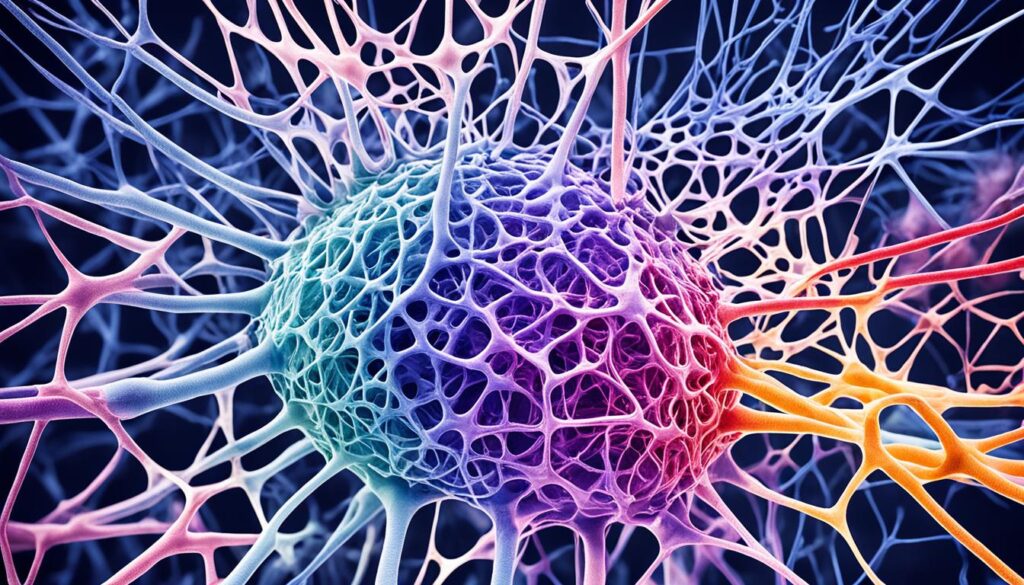
| Immune System Abnormalities in ME/CFS | Effects |
|---|---|
| Cytokine dysregulation | Chronic inflammation, immune dysfunction |
| Changes in B-cell subsets | Abnormal antibody production, ongoing immune response |
| Decreased NK cell function | Reduced ability to identify and destroy infected or cancerous cells |
| Decreased T cell function | Impaired immune response coordination |
| Autoantibodies | Potential autoimmune involvement |
Other Potential Factors in ME/CFS
In addition to infections and immune system abnormalities, several other factors can contribute to the development and progression of Myalgic Encephalomyelitis/Chronic Fatigue Syndrome (ME/CFS). Understanding these factors is crucial for effective management and treatment.
Post-Exertional Malaise
One hallmark feature of ME/CFS is post-exertional malaise (PEM). This refers to a worsening of symptoms after physical or mental exertion. Even minor activities that wouldn't normally cause fatigue can lead to a significant increase in symptoms, lasting for days or even weeks. The exact mechanisms underlying PEM are still not fully understood, but it is believed to involve dysregulation of the immune system and energy metabolism.
Comorbid Illnesses
ME/CFS is often accompanied by comorbid illnesses, meaning individuals may have multiple medical conditions simultaneously. Common comorbidities seen in ME/CFS patients include anxiety, depression, fibromyalgia, irritable bowel syndrome (IBS), and migraine headaches. These conditions can further complicate the management of ME/CFS as some treatments may worsen symptoms or interact with other medications.
Effective management of comorbid illnesses in ME/CFS requires a multidisciplinary approach, where healthcare professionals from different specialties work together to address the unique needs of each patient.
Note: The table below summarizes some common comorbid illnesses observed in ME/CFS:
| Comorbid Illness | Description |
|---|---|
| Anxiety | A mental health disorder characterized by excessive worrying, fear, and restlessness. |
| Depression | A mood disorder causing persistent feelings of sadness, hopelessness, and loss of interest in activities. |
| Fibromyalgia | A chronic disorder characterized by widespread musculoskeletal pain, fatigue, and sleep disturbances. |
| Irritable Bowel Syndrome (IBS) | A gastrointestinal disorder causing abdominal pain, bloating, and changes in bowel habits. |
| Migraine Headaches | A neurological disorder characterized by recurrent headaches, often accompanied by nausea and sensitivity to light and sound. |
It is recommended to work closely with healthcare providers to manage both ME/CFS symptoms and any comorbid illnesses effectively.
A comprehensive, individualized treatment plan that considers all contributing factors is essential for improving the overall well-being and quality of life of individuals with ME/CFS.
Current Treatment Approaches
While there is currently no FDA-approved cure for ME/CFS, there are various treatment options available. Gone are the days when cognitive behavioral therapy (CBT) and graded exercise therapy (GET) were considered the go-to treatments for ME/CFS. Today, a multidisciplinary approach is favored, which takes into account both pharmacological and non-pharmacological treatments, offering a more comprehensive and personalized approach.
Non-pharmacological treatments play a crucial role in managing ME/CFS symptoms. These treatments focus on improving patients' quality of life and include strategies such as pacing, energy management, and symptom management techniques. By carefully balancing activities and energy expenditure, patients can better manage their symptoms and prevent flare-ups.
Additionally, the multidisciplinary approach considers comorbid illnesses that may be present in ME/CFS patients. It recognizes that addressing these comorbidities is essential for an effective treatment plan. Each condition and its respective treatments are taken into account to minimize any potential aggravation of ME/CFS symptoms.
Education, support, and self-care strategies are also vital components of the treatment approach. By providing patients with knowledge about their condition and equipping them with the tools to manage their symptoms, they can regain a sense of control and actively participate in their own care.

| Treatment Approach | Description |
|---|---|
| Cognitive Behavioral Therapy (CBT) | A form of therapy that helps patients identify and modify negative thought patterns and behaviors related to their condition, promoting better coping mechanisms and improved psychological well-being. |
| Graded Exercise Therapy (GET) | A structured exercise program that gradually increases activity levels over time, with the goal of improving physical function and stamina. However, GET has faced criticism due to potential exacerbation of symptoms in some ME/CFS patients. |
| Pacing | A technique where patients carefully balance rest and activity to avoid overexertion. By managing their energy levels and pacing themselves, patients can minimize symptoms and maintain a more stable condition. |
| Energy Management | Strategies that involve conserving energy by breaking tasks into manageable segments, prioritizing activities, and establishing daily routines. By effectively managing their energy, patients can reduce fatigue and prevent crashes. |
| Symptom Management Techniques | Various approaches to manage specific symptoms, such as pain, sleep disturbances, and cognitive difficulties. These techniques may include medication, relaxation techniques, and adaptive strategies. |
It's important to note that treatment for ME/CFS should be individualized, considering each patient's unique circumstances and needs. The focus is on improving overall well-being and functional capacity rather than seeking a complete cure.
Conclusion
Managing and treating Myalgic Encephalomyelitis/Chronic Fatigue Syndrome (ME/CFS) is a complex task that requires a comprehensive approach. Recent research has provided valuable insights into the underlying mechanisms and potential therapeutic targets for ME/CFS. Understanding the role of infections, immune system abnormalities, and other contributing factors is crucial for the development of effective treatments.
A multidisciplinary and individualized approach is recommended for treating and managing ME/CFS. This approach should consider both pharmacological and non-pharmacological options. Non-pharmacological treatments such as energy management, pacing, and symptom management strategies play a vital role in alleviating ME/CFS symptoms. It is also important to take into account comorbid illnesses and their treatments.
While current treatment options are limited, ongoing research offers hope for the future. Further investigations are needed to explore the effectiveness of antiviral therapies, immunomodulators, and other treatment approaches. With advancements in research and a better understanding of ME/CFS, new and improved treatments are expected to emerge, offering relief and improved quality of life for ME/CFS patients.
FAQ
What is Myalgic Encephalomyelitis/Chronic Fatigue Syndrome (ME/CFS)?
Myalgic Encephalomyelitis/Chronic Fatigue Syndrome (ME/CFS) is a debilitating illness characterized by profound fatigue, exercise intolerance, and cognitive problems. It affects over 4 million people in the U.S. and has a significant impact on daily functioning and quality of life.
What are the symptoms of ME/CFS?
Common symptoms of ME/CFS include debilitating fatigue, brain fog, and post-exertional malaise. Symptoms often worsen after minimal exertion.
What role do infections play in ME/CFS?
Infections, particularly herpesviruses like Epstein-Barr virus (EBV), have been associated with the development of ME/CFS. Reactivation of these viruses may contribute to immune system dysfunction and inflammation seen in ME/CFS.
What immune system abnormalities are associated with ME/CFS?
ME/CFS is associated with various immune system abnormalities, including changes in cytokine profiles, increased numbers of B-cell subsets, and decreased natural killer (NK) and T cell function. Autoantibodies, indicating an autoimmune aspect, are also found in some ME/CFS patients.
What are the other potential factors contributing to ME/CFS?
In addition to infections and immune system abnormalities, factors such as post-exertional malaise and comorbid illnesses like anxiety, depression, fibromyalgia, irritable bowel syndrome, and migraine headaches can contribute to ME/CFS.
What are the current treatment approaches for ME/CFS?
There is currently no FDA-approved cure for ME/CFS. The focus has shifted to a multidisciplinary approach that considers both pharmacological and non-pharmacological treatments. Non-pharmacological treatments such as pacing, energy management, and symptom management strategies play a crucial role in managing ME/CFS symptoms.
What does the future of ME/CFS treatment and research look like?
Ongoing research is providing new insights into the mechanisms and potential therapeutic targets for ME/CFS. Further research is needed to explore the effectiveness of antiviral therapies, immunomodulators, and other treatment approaches. With continued advancements, there is hope for new and improved treatments for ME/CFS patients.
Source Links
- https://www.nih.gov/news-events/nih-research-matters/insight-into-mechanisms-mecfs
- https://www.npr.org/sections/health-shots/2024/02/23/1232794456/clues-to-a-better-understanding-of-chronic-fatigue-syndrome-emerge-from-major-st
- https://www.mdpi.com/2077-0383/13/2/325
Complex Regional Pain Syndrome Diagnosis Guide
Diagnosing CRPS is a complex process that relies on a thorough physical examination and evaluation of medical history. While there is no single test that can definitively diagnose CRPS, certain procedures can provide important clues to confirm the diagnosis.
These procedures often include bone scans, sweat production tests, X-rays, and magnetic resonance imaging (MRI). Each procedure helps healthcare professionals gather valuable insights into the condition and rule out other potential causes of your symptoms. By examining these test results alongside your medical history and physical examination findings, healthcare providers can arrive at a diagnosis.
Once diagnosed, the key to managing CRPS lies in a combination of medications, therapies, and lifestyle changes. In the following sections of this article, we will delve into each aspect of CRPS diagnosis and treatment, providing you with valuable information to help you navigate this challenging condition.
Procedures for Diagnosing CRPS
Diagnosing complex regional pain syndrome (CRPS) involves a series of procedures that provide valuable insights into the condition. While there is no single test that can definitively diagnose CRPS, these procedures help healthcare professionals understand the underlying factors contributing to the patient's symptoms.
A bone scan is one of the procedures used to identify bone changes associated with CRPS. By injecting a small amount of radioactive material into the body, healthcare providers can detect abnormalities in bone metabolism. This information is crucial in ruling out other conditions and confirming a CRPS diagnosis.
Another procedure used in the diagnosis of CRPS is sweat production testing. This test measures the difference in sweat production between the affected limb and the unaffected limb. It helps healthcare providers assess the autonomic nervous system's involvement in CRPS and can provide further evidence for a diagnosis.
X-rays are commonly used to detect changes in bone mineral density in later stages of CRPS. Loss of minerals from bones is a characteristic feature of the disease, and X-rays can reveal these changes. Additionally, X-rays can help rule out other potential causes of symptoms, such as fractures or joint abnormalities.
An MRI (magnetic resonance imaging) is a non-invasive procedure that provides detailed images of the body's internal structures. It can be particularly helpful in diagnosing CRPS by revealing tissue changes that may not be visible on X-rays. The information obtained from an MRI aids in ruling out other conditions and confirming a diagnosis of CRPS.
Although these procedures do not provide a definitive diagnosis on their own, they play a crucial role in the diagnostic process, contributing essential information and ruling out other potential causes of the patient's symptoms.
Medications for Treating CRPS
The treatment of Complex Regional Pain Syndrome (CRPS) often involves the use of medications to alleviate symptoms and improve quality of life. Medications can help manage pain, reduce inflammation, and address associated symptoms. The choice of medication depends on the severity of the condition and the specific needs of the individual.
Pain Relievers
Pain relievers, such as aspirin, ibuprofen, and naproxen sodium, can be effective in managing mild pain and reducing inflammation associated with CRPS. These over-the-counter nonsteroidal anti-inflammatory drugs (NSAIDs) can help provide relief in the early stages of the condition.
Stronger Pain Relievers
In cases of more severe pain, stronger pain relievers may be prescribed by a healthcare professional. Opioid medications, such as codeine or oxycodone, can provide relief for individuals experiencing intense pain that is not effectively managed by over-the-counter medications. These medications should be used under the close supervision and guidance of a healthcare provider due to their potential for dependence and side effects.
Antidepressants
Neuropathic pain, a common symptom of CRPS, can often be managed with the use of antidepressant medications. Tricyclic antidepressants, such as amitriptyline or nortriptyline, and selective serotonin and norepinephrine reuptake inhibitors (SNRIs), such as duloxetine, can help alleviate pain and improve mood by affecting the brain's perception of pain. These medications can also address any associated symptoms of depression or anxiety.
Anticonvulsants
Anticonvulsant medications, typically used to treat seizures, can also be beneficial in managing neuropathic pain. Medications such as gabapentin or pregabalin help stabilize nerve activity and reduce the transmission of pain signals. These medications can be particularly effective in individuals who experience burning or shooting pain in CRPS-affected areas.
Corticosteroids
Corticosteroids, such as prednisone or methylprednisolone, are anti-inflammatory medications that can help reduce inflammation and improve mobility in individuals with CRPS. These medications are often used in the early stages of the condition to reduce swelling and promote healing. Corticosteroids may be administered orally or through injections directly into the affected area.
Bone-Loss Medications
CRPS can sometimes lead to bone loss or osteoporosis in the affected limb. In such cases, medications aimed at preventing or treating bone loss may be prescribed. These medications, such as bisphosphonates or calcitonin, help improve bone density and reduce the risk of fractures.

It is important to note that the use of medications in CRPS treatment should be done under the guidance and supervision of a healthcare professional. They will consider the individual's specific symptoms, medical history, and any potential interactions with other medications. The goal of medication use in CRPS is to alleviate pain, reduce inflammation, and improve overall function and quality of life.
| Medication Type | Examples | Purpose |
|---|---|---|
| Pain Relievers | Aspirin, ibuprofen, naproxen sodium | Manage mild pain and reduce inflammation |
| Stronger Pain Relievers | Codeine, oxycodone | Provide relief for severe pain |
| Antidepressants | Amitriptyline, nortriptyline, duloxetine | Alleviate neuropathic pain and improve mood |
| Anticonvulsants | Gabapentin, pregabalin | Stabilize nerve activity and reduce pain transmission |
| Corticosteroids | Prednisone, methylprednisolone | Reduce inflammation and improve mobility |
| Bone-Loss Medications | Bisphosphonates, calcitonin | Prevent or treat bone loss in affected limb |
Therapies for Managing CRPS
Various therapies can help manage CRPS symptoms. By incorporating these therapies into a comprehensive treatment plan, individuals with CRPS can experience relief and improved quality of life.
Heat Therapy
Heat therapy is a non-invasive technique that can provide relief for swelling and discomfort associated with CRPS. Applying a warm compress or using warm water treatments can help promote blood flow, reduce muscle tension, and alleviate pain.
Topical Analgesics
Topical analgesics, such as capsaicin cream and lidocaine patches, can be applied directly to the affected area to reduce hypersensitivity and provide localized pain relief. These medications work by blocking pain signals and numbing the skin.
Physical Therapy
Physical therapy plays a crucial role in managing CRPS by improving range of motion, strength, and function of the affected limb. A skilled physical therapist can design a personalized exercise program focused on stretching and strengthening exercises to enhance mobility and reduce pain.
Mirror Therapy
Mirror therapy is a unique approach that uses a mirror to trick the brain into perceiving improvement in function and reducing pain. By reflecting the image of the unaffected limb onto the affected limb, mirror therapy can help improve motor control and reduce CRPS-related symptoms.
Transcutaneous Electrical Nerve Stimulation (TENS)
TENS is a therapy that uses a small device to deliver low-intensity electrical currents to the affected area. These electrical impulses help to disrupt pain signals, stimulate natural pain-relieving mechanisms, and promote circulation, providing temporary relief from CRPS symptoms.
Biofeedback Techniques
Biofeedback techniques involve using electronic sensors to monitor physiological responses and provide real-time feedback. This therapy helps individuals with CRPS learn to control their body's responses to pain, stress, and other triggers. By mastering these techniques, individuals can reduce pain perception and increase relaxation.
These therapies, combined with other treatment modalities, such as medications and lifestyle changes, can play a vital role in managing CRPS symptoms and improving overall well-being.
Coping and Support for CRPS
Living with a chronic and painful condition like CRPS can be challenging. It's important to find ways to cope with the physical and emotional impacts of the condition. Here are some strategies that can help:
Maintaining Daily Activities
Despite the challenges posed by CRPS, it's important to try to maintain your typical daily activities as much as possible. This can help you maintain a sense of normalcy and routine, which can be beneficial for your overall well-being.
Staying Connected
Staying connected with friends and family is essential for emotional support. Lean on your loved ones for comfort and understanding. Sharing your experiences and feelings with others who care about you can provide a sense of belonging and reduce feelings of isolation.
Pursuing Hobbies
Continuing to pursue hobbies and activities that you enjoy is an important part of maintaining a fulfilling life with CRPS. Engaging in activities that bring you joy can help distract from pain and improve your overall mood. It's crucial to find hobbies that you can still enjoy despite your condition.
Seeking Professional Help
Dealing with CRPS can be overwhelming, and it's okay to ask for help. Seeking professional help, such as therapy or joining a support group, can provide valuable coping skills and emotional support. Mental health professionals can offer guidance and strategies to help you navigate the challenges of living with CRPS.
Remember, everyone's experience with CRPS is unique, so find the coping mechanisms that work best for you. Be patient with yourself and give yourself time to adjust. With the right support and strategies, you can find ways to manage the challenges of living with CRPS and lead a fulfilling life.

Preparing for a CRPS Appointment
To make the most of your CRPS appointment, it's important to prepare beforehand. Here are some steps you can take to ensure a productive and informative discussion with your healthcare provider:
- Note your symptoms: Make a detailed note of your symptoms, including the severity, location of pain, stiffness, or sensitivity. This can help your healthcare provider better understand your condition and develop an appropriate treatment plan.
- Prepare questions: Write down any questions you have for your healthcare provider. These may include inquiries about the likely cause of your symptoms, recommended tests and treatments, alternative approaches, and management of existing health conditions. Having your questions written down ensures that you don't forget to ask anything important.
- Gather information: It's helpful to gather information about CRPS from reliable sources. This can include articles, research papers, or websites dedicated to providing accurate and up-to-date information about the condition. Sharing this information with your loved ones can also help them understand your situation better and provide you with the support you need.
Taking these steps before your CRPS appointment can help you make the most of your time with your healthcare provider and ensure that all your concerns are addressed. Remember, effective communication and preparation are key to receiving the best possible care.
Treatment Approaches for CRPS
Early treatment plays a crucial role in improving symptoms and managing complex regional pain syndrome (CRPS). To effectively address this condition, a combination of therapies tailored to the individual's specific case is often necessary. Treatment approaches may include:
- Physical therapy: A cornerstone of CRPS treatment, physical therapy aims to improve functionality, reduce pain, and enhance overall quality of life. Through targeted exercises, physical therapists work to improve blood flow, flexibility, strength, and muscle tone in the affected limb. Techniques such as graded motor imagery, mirror therapy, and desensitization may also be utilized to alleviate pain and restore function. The use of physical therapy for CRPS treatment is supported by the latest research and clinical evidence.
- Occupational therapy: Occupational therapists play a vital role in helping individuals with CRPS regain independence and resume daily activities. They provide guidance and assistive devices to manage pain and increase functionality in daily tasks.
- Lifestyle changes: Making certain lifestyle modifications can greatly contribute to managing CRPS symptoms. These may include quitting smoking, managing existing health conditions, such as diabetes and poor circulation, and keeping the affected limb elevated while resting or sleeping to reduce swelling. Regular exercise and wearing compression stockings or sleeves may also be recommended to enhance circulation and minimize swelling.
- Psychosocial and behavioral therapy: CRPS is often associated with emotional challenges such as anxiety, depression, and stress, which can exacerbate pain. Psychosocial and behavioral therapy, including talk therapy, can provide valuable support in managing these emotional factors. By identifying and addressing unhealthy thoughts, behaviors, and emotions, individuals can develop effective coping strategies and improve overall well-being.
- Medications: In some cases, medications may be prescribed to manage pain and alleviate accompanying symptoms of CRPS. Pain relievers, antidepressants, anticonvulsants, and corticosteroids are commonly used to address neuropathic pain, reduce inflammation, and improve mobility. However, it's crucial to work closely with a healthcare professional to determine the most appropriate medication regimen for each individual.
- Alternative therapies for pain management: Complementary approaches, such as acupuncture, chiropractic care, and meditation, may be considered as part of a comprehensive CRPS treatment plan. These therapies can provide additional pain relief and support overall well-being.
It's important to note that each person's treatment plan for CRPS will vary based on their unique needs and symptoms. Consulting with a multidisciplinary team of healthcare professionals, including physical therapists, occupational therapists, and pain management specialists, is crucial for developing a tailored treatment approach that addresses the comprehensive needs of individuals with CRPS.

| Treatment Approaches | Description |
|---|---|
| Physical therapy | Aims to improve blood flow, flexibility, strength, and muscle tone. Uses techniques like graded motor imagery, mirror therapy, and desensitization. |
| Occupational therapy | Assists individuals in regaining independence and resuming daily activities with guidance and assistive devices. |
| Lifestyle changes | Involves quitting smoking, managing health conditions, keeping the affected limb elevated, regular exercise, and wearing compression stockings. |
| Psychosocial and behavioral therapy | Provides support in managing anxiety, depression, and stress through talk therapy and coping strategy development. |
| Medications | Pain relievers, antidepressants, anticonvulsants, and corticosteroids may be prescribed to manage pain and reduce inflammation. |
| Alternative therapies | Complementary approaches such as acupuncture, chiropractic care, and meditation may provide additional pain relief. |
Importance of Physical Therapy for CRPS
As an essential component of CRPS treatment, physical therapy plays a crucial role in improving the overall well-being of individuals with the condition. Through targeted exercises and techniques, a physical therapist can help enhance blood flow to the affected limb, improve flexibility, strength, muscle tone, and overall function.
Physical therapy for CRPS involves a variety of approaches that aim to reduce pain, improve movement, and re-establish the brain's perception of the affected limb. Some of these techniques include:
- Graded motor imagery: This therapy involves a step-by-step progression of mental exercises that aim to retrain the brain's response to movement and reduce pain.
- Mirror therapy: By using a mirror to create an illusion of movement in the affected limb, mirror therapy can improve motor function, alleviate pain, and enhance body awareness.
- Desensitization: This approach focuses on gradually exposing the affected limb to different textures, temperatures, and stimuli to reduce hypersensitivity and improve tolerance.
By incorporating physical therapy into the treatment plan, individuals with CRPS have the opportunity to regain control over their symptoms and improve their quality of life. The exercises and techniques employed by physical therapists help promote better blood flow, which can aid in the healing process. Additionally, through targeted exercises, individuals can enhance their flexibility, strength, and muscle tone, allowing them to regain function and increase their range of motion.
Physical therapy sessions are typically tailored to the individual's specific needs and may involve a combination of exercises, manual techniques, and therapeutic modalities. The guidance and support provided by a physical therapist are vital in helping individuals overcome physical obstacles and achieve their rehabilitation goals.
It is important to consult a healthcare professional or specialist trained in CRPS to determine the most suitable physical therapy program for each individual's unique circumstances. By working closely with a physical therapist, individuals with CRPS can take an active role in their recovery and regain control over their lives.
Lifestyle Changes for Managing CRPS
Making certain lifestyle changes can greatly contribute to the management of CRPS symptoms. By incorporating these changes into your daily routine, you can improve your overall well-being and find relief from the discomfort associated with CRPS.
1. Quit Smoking
One of the most important lifestyle changes for managing CRPS is quitting smoking. Smoking interferes with nerve regeneration and can worsen the symptoms of CRPS. By quitting smoking, you give your body a better chance to heal and improve your overall health.
2. Manage Health Conditions
Managing any existing health conditions is crucial for nerve healing and symptom management in CRPS. If you have diabetes or poor circulation, it's important to follow a healthy diet, take prescribed medications, and monitor your blood sugar levels regularly. By effectively managing these conditions, you can support nerve healing and minimize the impact of CRPS.
3. Keep the Affected Limb Elevated
Keeping the affected limb elevated while resting or sleeping can help reduce swelling and improve circulation. Elevating the limb helps to counteract the pooling of blood and fluid, which commonly occurs in CRPS. By elevating the limb, you can alleviate discomfort and promote better circulation to the affected area.
4. Regular Exercise
Engaging in regular exercise is beneficial for overall health and can also help manage CRPS symptoms. Exercise improves blood circulation, which aids in reducing inflammation and relieving pain. It's important to start with gentle exercises and gradually increase intensity as tolerated. Consult with your healthcare provider or a physical therapist to develop an exercise plan that suits your specific needs and abilities.
5. Compression Stockings
Wearing compression stockings or sleeves can help limit swelling in the affected limb. Compression garments apply gentle pressure, which supports blood flow and reduces fluid retention. Talk to your healthcare provider about the appropriate compression level and type of garment to use.

By incorporating these lifestyle changes into your daily routine, you can take an active role in managing CRPS symptoms. Quitting smoking, managing existing health conditions, keeping the affected limb elevated, engaging in regular exercise, and wearing compression stockings can significantly contribute to symptom relief and overall well-being.
Psychosocial and Behavioral Therapy for CRPS
Living with Complex Regional Pain Syndrome (CRPS) can be emotionally challenging, as it is often accompanied by anxiety, depression, and stress that can worsen pain symptoms. Fortunately, psychosocial and behavioral therapy offers effective strategies for managing these emotional factors and improving overall well-being.
Talk therapy, also known as psychotherapy, is a key component of psychosocial and behavioral therapy for CRPS. By working with a pain management clinical psychologist who specializes in CRPS, individuals can learn coping strategies specifically tailored to their unique circumstances and address the underlying factors contributing to their pain and symptoms.
Through psychotherapy sessions, individuals can explore and identify unhealthy thoughts, behaviors, and emotions that may be exacerbating their pain. By promoting positive cognitive and behavioral changes, talk therapy helps individuals develop healthier coping mechanisms and a more optimistic outlook on life.
Pain Coping Strategies
As part of psychosocial and behavioral therapy, patients are taught pain coping strategies that can effectively alleviate CRPS symptoms. These strategies include:
- Deep breathing exercises
- Progressive muscle relaxation
- Mindfulness meditation
- Stress management techniques
- Positive visualization
- Journaling
By incorporating these strategies into their daily lives, individuals with CRPS can better manage their anxiety, depression, and stress levels, thereby reducing the impact of these emotional factors on their pain experience.
In addition to talk therapy and pain coping strategies, psychosocial and behavioral therapy may include other modalities such as cognitive-behavioral therapy (CBT) and acceptance and commitment therapy (ACT). These therapies focus on changing negative thought patterns, developing acceptance of one's condition, and committing to actions that align with personal values.
It is important to note that psychosocial and behavioral therapy should not replace other components of CRPS management, such as physical therapy, medications, and lifestyle changes. Instead, it should be integrated into a holistic treatment approach that addresses the physical, emotional, and psychological aspects of CRPS.
Psychosocial and behavioral therapy for CRPS provides individuals with the tools and support they need to effectively manage their pain, improve their quality of life, and regain control over their emotional well-being.
Conclusion
In conclusion, the treatment of Complex Regional Pain Syndrome (CRPS) requires a holistic and multidisciplinary approach. While there is no cure for CRPS, early intervention and a combination of therapies can significantly improve symptoms and enhance quality of life. It is crucial to develop individualized treatment plans that address the unique needs of each person with CRPS, incorporating physical therapy, medications, lifestyle modifications, and psychosocial support.
By adopting a comprehensive approach, we can effectively manage the physical, emotional, and psychological aspects of CRPS. Physical therapy plays a vital role in improving blood flow, flexibility, strength, muscle tone, and overall function. Medications can help alleviate pain and inflammation, while lifestyle changes such as quitting smoking, managing underlying health conditions, and regular exercise can contribute to symptom relief.
Additionally, psychosocial support is essential in addressing the emotional and psychological impact of CRPS. Seeking help from a pain management clinical psychologist and utilizing talk therapy can assist individuals in managing anxiety, depression, and stress associated with the condition. In this way, we can develop effective pain coping strategies and promote overall well-being.
FAQ
What procedures are used to diagnose CRPS?
The diagnosis of CRPS may involve bone scans, sweat production tests, X-rays, and MRI. These procedures can provide important clues to confirm the condition.
Are there any specific medications used in the treatment of CRPS?
Yes, medications like pain relievers, antidepressants, anticonvulsants, and corticosteroids are commonly prescribed to help manage the symptoms of CRPS.
What therapies can be used to manage CRPS?
Therapies such as heat therapy, topical analgesics, physical therapy, mirror therapy, TENS, and biofeedback techniques can be beneficial in managing CRPS symptoms.
How can I cope with living with CRPS?
It is important to maintain daily activities, stay connected with friends and family, pursue hobbies, and seek professional help or therapy to develop coping skills and emotional support.
How can I prepare for a CRPS appointment?
Prior to your appointment, make note of your symptoms and questions, as well as gather information about CRPS from reliable sources to share with your healthcare provider.
What are the treatment approaches for CRPS?
Treatment for CRPS often involves a combination of therapies tailored to the individual's needs, such as physical therapy, medications, lifestyle changes, and psychosocial support.
Why is physical therapy important in the treatment of CRPS?
Physical therapy can help improve blood flow, flexibility, strength, muscle tone, and function of the affected limb through targeted exercises and techniques such as mirror therapy and desensitization.
Are there any lifestyle changes that can help manage CRPS?
Yes, lifestyle changes such as quitting smoking, managing existing health conditions, elevating the affected limb, regular exercise, and wearing compression stockings can aid in managing CRPS symptoms.
Can psychosocial and behavioral therapy help with CRPS?
Yes, psychosocial and behavioral therapy, including talk therapy, can be beneficial in managing anxiety, depression, and stress associated with CRPS and teach coping strategies to address emotional factors.
What is the importance of a comprehensive, multidisciplinary approach in CRPS diagnosis and treatment?
A comprehensive approach that considers both physical and psychological factors is crucial in managing CRPS. This can involve a combination of therapies, medications, and individualized treatment plans to improve symptoms and quality of life.
Source Links
- https://my.clevelandclinic.org/health/diseases/12085-complex-regional-pain-syndrome-crps
- https://www.ncbi.nlm.nih.gov/books/NBK430719/
- https://www.mayoclinic.org/diseases-conditions/crps-complex-regional-pain-syndrome/diagnosis-treatment/drc-20371156
Understanding Ataxic Cerebral Palsy - Key Facts
In this article, we will provide you with key facts about ataxic cerebral palsy which affects coordination and movement. If you or someone you know has been diagnosed with ataxic cerebral palsy, it is important to understand the condition and the available treatment options.
Ataxic cerebral palsy is caused by damage to the cerebellum, the part of the brain responsible for motor control. It affects a person's ability to coordinate movements and maintain balance. Individuals with ataxic cerebral palsy often experience difficulties with precise movements, walking, balance, and depth perception.
In this article, we will delve into the causes, symptoms, and treatment options for ataxic cerebral palsy. We will explore how physical therapy, occupational therapy, speech therapy, and medication can help manage the condition and improve the quality of life for those affected. Understanding these treatment options is crucial for individuals with ataxic cerebral palsy and their families.
Continue reading to gain a deeper insight into ataxic cerebral palsy and discover the best ways to support individuals with this condition. Our aim is to provide you with valuable information, helpful resources, and empower you to make informed decisions regarding treatment and care.
What is Ataxic Cerebral Palsy?
Ataxic cerebral palsy is a type of developmental disorder that affects motor function. It is characterized by problems with balance and coordination, making it difficult for individuals to control their movements effectively. This condition occurs due to damage to the cerebellum, a crucial part of the brain responsible for motor control.
Children with ataxic cerebral palsy often experience shaky and imprecise movements, which can impact various parts of their body, including their hands, arms, legs, feet, eyes, and speech. The challenges they face in controlling their movements can affect their overall motor skills and coordination.
Individuals with ataxic cerebral palsy may struggle with activities requiring balance, such as walking and maintaining a stable posture. They may also experience difficulties in performing precise actions, such as grasping objects or coordinating fine motor movements.
Image:

Causes and Risk Factors of Ataxic Cerebral Palsy
Ataxic cerebral palsy is a type of cerebral palsy that is caused by a brain injury to the cerebellum either before, during, or shortly after birth. The cerebellum is responsible for motor control, balance, and coordination. When it is damaged, it can lead to difficulties in movement and coordination.
There are several factors that can contribute to damage to the cerebellum and the development of ataxic cerebral palsy. These include:
- Infections in the womb: Infections during pregnancy, such as rubella or cytomegalovirus, can increase the risk of brain damage in the developing fetus, including the cerebellum.
- Loss of oxygen during birth: Lack of oxygen, also known as birth asphyxia, can cause brain injury and affect the cerebellum. This can happen during a difficult or prolonged labor, umbilical cord problems, or placental complications.
- Head trauma: Traumatic brain injuries, like those caused by accidents or falls, can damage the cerebellum and lead to ataxic cerebral palsy.
- Brain hemorrhaging: Bleeding in the brain, particularly in the cerebellum, can cause damage and result in ataxic cerebral palsy.
Additionally, certain risk factors increase the likelihood of developing ataxic cerebral palsy. These include:
- Poor maternal health: Maternal health conditions such as high blood pressure, infections, or substance abuse during pregnancy can increase the risk of brain injury in the developing fetus.
- Possible brain injury from abuse: Infants who experience physical abuse or shaken baby syndrome may sustain brain injuries, including damage to the cerebellum.
Early identification of these risk factors and appropriate medical intervention can play a crucial role in the prevention and management of ataxic cerebral palsy.

| Causes | Risk Factors |
|---|---|
| Brain injury to the cerebellum before, during, or shortly after birth | Poor maternal health |
| Infections in the womb | Possible brain injury from abuse |
| Loss of oxygen during birth | |
| Head trauma | |
| Brain hemorrhaging |
Signs and Symptoms of Ataxic Cerebral Palsy
The primary symptoms of ataxic cerebral palsy are problems with balance and coordination of motor skills. Children with ataxic cerebral palsy may experience:
- Imprecise motor skills
- Difficulty walking and balancing
- Issues with depth perception
- Tremors and shakiness
- Walking with feet spread far apart
- Trouble bringing hands together
- Unsteady gait
- Trouble grasping objects
- Over-correcting movements
- Trouble with repetitious movements
- Struggling with speech
- Slow eye movements
These symptoms can vary in severity and may present differently in each individual with ataxic cerebral palsy.

| Signs and Symptoms | Description |
|---|---|
| Imprecise motor skills | Difficulty performing precise movements and tasks that require fine motor control. |
| Difficulty walking and balancing | Problems with maintaining balance and walking steadily. |
| Issues with depth perception | Difficulty judging distances and perceiving depth accurately. |
| Tremors and shakiness | Involuntary shaking or trembling movements. |
| Walking with feet spread far apart | A wide-based gait, with the feet positioned further apart than usual while walking. |
| Trouble bringing hands together | Difficulty coordinating movements to bring the hands together. |
| Unsteady gait | An unsteady and uncoordinated walking pattern. |
| Trouble grasping objects | Difficulty with gripping and holding objects. |
| Over-correcting movements | Making exaggerated movements to compensate for lack of coordination. |
| Trouble with repetitious movements | Difficulties with executing repetitive actions smoothly. |
| Struggling with speech | Challenges with articulation, producing sounds, and clear speech. |
| Slow eye movements | Delayed or slow eye movements, affecting visual tracking and coordination. |
Treatment for Ataxic Cerebral Palsy
When it comes to managing ataxic cerebral palsy, a comprehensive treatment approach is crucial. The main treatment modalities for this condition include physical therapy, occupational therapy, speech therapy, and medication. Let's take a closer look at each of these interventions and how they can help improve the quality of life for children with ataxic cerebral palsy.
Physical Therapy
Physical therapy plays a vital role in addressing movement difficulties and promoting independence in children with ataxic cerebral palsy. Through a combination of strength and flexibility exercises, massage therapy, and the use of orthotic devices, physical therapists aim to improve motor function and enhance overall physical well-being. These interventions can help children develop better control over their movements, increase stability, and enhance their overall coordination.
Occupational Therapy
Occupational therapy focuses on improving balance, coordination, and upper body strength to empower children with ataxic cerebral palsy to perform their daily tasks independently. Occupational therapists work closely with children and their families to develop personalized strategies and interventions that address the specific challenges they face. By implementing specialized techniques and adaptive equipment, occupational therapy can enhance a child's ability to participate in activities such as self-care, schoolwork, and leisure activities.
Speech Therapy
Speech therapy plays a crucial role in improving communication and swallowing abilities in children with ataxic cerebral palsy. Speech-language pathologists work with children to strengthen the muscles used for speech and swallowing, enhance articulation, and improve overall clarity of speech. Through targeted exercises, speech therapy aims to help children overcome speech difficulties and develop effective communication skills, which are essential for social interaction and academic success.
Medication
In certain cases, medication may be prescribed to manage the symptoms associated with ataxic cerebral palsy and treat co-occurring conditions. Muscle relaxants can help reduce muscle stiffness and spasms, improving overall mobility and comfort. Anti-anxiety medications may be prescribed to alleviate anxiety and promote relaxation. It's important to note that medication should always be used in conjunction with other therapies and under the guidance of a healthcare professional.
By combining these various treatment approaches, children with ataxic cerebral palsy can experience improvements in movement control, coordination, speech, and overall quality of life. It's important to work closely with a team of healthcare professionals to develop an individualized treatment plan that addresses the unique needs of each child.
Types of Cerebral Palsy
Cerebral palsy is a group of disorders that affect movement and posture. There are different types of cerebral palsy, including:
- Spastic cerebral palsy: This is the most common type of cerebral palsy, characterized by stiff muscles. People with spastic cerebral palsy may have difficulty controlling their movements and may experience muscle tightness and spasms.
- Dyskinetic cerebral palsy: This type of cerebral palsy involves uncontrollable movements. People with dyskinetic cerebral palsy may have involuntary muscle contractions, resulting in twisting, writhing, or jerking movements.
- Ataxic cerebral palsy: Ataxic cerebral palsy affects balance and coordination. Individuals with ataxic cerebral palsy may have difficulties with precise movements, walking, balance, and depth perception.
- Mixed cerebral palsy: Some individuals may have a mixed type of cerebral palsy, combining symptoms of different types. This can result in a combination of spastic, dyskinetic, or ataxic features.
Table
| Type of Cerebral Palsy | Description |
|---|---|
| Spastic | Characterized by stiff muscles and difficulty controlling movements |
| Dyskinetic | Involuntary muscle contractions leading to twisting or jerking movements |
| Ataxic | Affects balance and coordination, resulting in difficulties with precise movements, walking, balance, and depth perception |
| Mixed | A combination of symptoms from different types of cerebral palsy |
Note: The table is a visual representation of the types of cerebral palsy and their associated descriptions.
Each type of cerebral palsy has its own set of movement disorders and symptoms. Understanding the specific type can help healthcare professionals develop targeted treatment plans to address the unique challenges faced by individuals with cerebral palsy.

Conclusion
Ataxic cerebral palsy is a rare but significant form of cerebral palsy that directly impacts coordination, balance, and motor skills. The condition results from damage to the cerebellum, which is responsible for controlling motor functions. Early identification and intervention play a crucial role in managing ataxic cerebral palsy and enhancing the child's overall quality of life.
Treatment for ataxic cerebral palsy typically involves a multidisciplinary approach. Physical therapy aims to improve coordination, enhance balance, and strengthen muscles. Occupational therapy focuses on developing essential skills for daily activities and enhancing independence. Speech therapy assists in overcoming speech and swallowing difficulties that may accompany the condition.
In addition to therapy, medication may be prescribed to manage symptoms and address any associated conditions. Muscle relaxants and anti-anxiety medications may be utilized to alleviate muscle stiffness and reduce anxiety levels. The combination of therapies and medication aims to improve coordination, balance, and motor skills, allowing children with ataxic cerebral palsy to lead fulfilling lives.
With the appropriate treatment and support, children with ataxic cerebral palsy can overcome the challenges presented by their condition. Empowering them with early intervention, therapy, and medication allows these remarkable individuals to develop their motor skills, improve coordination and balance, and achieve their full potential.
FAQ
What is ataxic cerebral palsy?
Ataxic cerebral palsy is a rare type of cerebral palsy that affects coordination, balance, and motor skills. It is caused by damage to the cerebellum, which plays a crucial role in motor control.
What are the causes and risk factors of ataxic cerebral palsy?
Ataxic cerebral palsy is caused by a brain injury to the cerebellum before, during, or shortly after birth. Various factors can lead to this damage, including infections in the womb, loss of oxygen during birth, head trauma, and brain hemorrhaging. Risk factors for ataxic cerebral palsy include poor maternal health and possible brain injury from abuse.
What are the signs and symptoms of ataxic cerebral palsy?
The primary symptoms of ataxic cerebral palsy include problems with balance and coordination of motor skills. Children with ataxic cerebral palsy may have imprecise motor skills, difficulty walking and balancing, issues with depth perception, and tremors and shakiness. Other developmental signs may include walking with feet spread far apart, trouble bringing hands together, unsteady gait, trouble grasping objects, over-correcting movements, trouble with repetitious movements, struggling with speech, and slow eye movements.
What are the treatment options for ataxic cerebral palsy?
The main treatments for ataxic cerebral palsy include physical therapy, occupational therapy, speech therapy, and medication. Physical therapy aims to improve movement problems and make children more independent through exercises, massage therapy, and orthotic devices. Occupational therapy focuses on improving balance, coordination, and upper body strength to help children perform daily tasks independently. Speech therapy helps children with ataxic cerebral palsy improve their speech and swallowing abilities. Medication, such as muscle relaxants and anti-anxiety medication, may be prescribed to manage symptoms and treat co-occurring conditions.
What are the types of cerebral palsy?
Cerebral palsy is a group of disorders that affect movement and posture. There are different types of cerebral palsy, including spastic cerebral palsy, which is the most common type characterized by stiff muscles, dyskinetic cerebral palsy, which involves uncontrollable movements, and ataxic cerebral palsy. Some individuals may have a mixed type of cerebral palsy, combining symptoms of different types. Each type has its own specific movement disorders and symptoms.
What is the outlook for individuals with ataxic cerebral palsy?
With proper treatment and support, children with ataxic cerebral palsy can lead fulfilling lives and overcome challenges associated with their condition. Early diagnosis and intervention are important for managing the condition and improving the child's quality of life.
Source Links
- https://www.cerebralpalsyguide.com/cerebral-palsy/types/ataxic/
- https://www.cerebralpalsyguidance.com/cerebral-palsy/types/ataxic/





